- Privacy Policy

Home » Table of Contents – Types, Formats, Examples

Table of Contents – Types, Formats, Examples
Table of Contents

Definition:
Table of contents (TOC) is a list of the headings or sections in a document or book, arranged in the order in which they appear. It serves as a roadmap or guide to the contents of the document, allowing readers to quickly find specific information they are looking for.
A typical table of contents includes chapter titles, section headings, subheadings, and their corresponding page numbers.
The table of contents is usually located at the beginning of the document or book, after the title page and any front matter, such as a preface or introduction.
Table of Contents in Research
In Research, A Table of Contents (TOC) is a structured list of the main sections or chapters of a research paper , Thesis and Dissertation . It provides readers with an overview of the organization and structure of the document, allowing them to quickly locate specific information and navigate through the document.
Importance of Table of Contents
Here are some reasons why a TOC is important:
- Navigation : It serves as a roadmap that helps readers navigate the document easily. By providing a clear and concise overview of the contents, readers can quickly locate the section they need to read without having to search through the entire document.
- Organization : A well-structured TOC reflects the organization of the document. It helps to organize the content logically and categorize it into easily digestible chunks, which makes it easier for readers to understand and follow.
- Clarity : It can help to clarify the document’s purpose, scope, and structure. It provides an overview of the document’s main topics and subtopics, which can help readers to understand the content’s overall message.
- Efficiency : This can save readers time and effort by allowing them to skip to the section they need to read, rather than having to go through the entire document.
- Professionalism : Including a Table of Contents in a document shows that the author has taken the time and effort to organize the content properly. It adds a level of professionalism and credibility to the document.
Types of Table of Contents
There are different types of table of contents depending on the purpose and structure of the document. Here are some examples:
Simple Table of Contents
This is a basic table of contents that lists the major sections or chapters of a document along with their corresponding page numbers.
Example: Table of Contents
I. Introduction …………………………………………. 1
II. Literature Review ………………………………… 3
III. Methodology ……………………………………… 6
IV. Results …………………………………………….. 9
V. Discussion …………………………………………. 12
VI. Conclusion ……………………………………….. 15
Expanded Table of Contents
This type of table of contents provides more detailed information about the contents of each section or chapter, including subsections and subheadings.
A. Background …………………………………….. 1
B. Problem Statement ………………………….. 2
C. Research Questions ……………………….. 3
II. Literature Review ………………………………… 5
A. Theoretical Framework …………………… 5
B. Previous Research ………………………….. 6
C. Gaps and Limitations ……………………… 8 I
II. Methodology ……………………………………… 11
A. Research Design ……………………………. 11
B. Data Collection …………………………….. 12
C. Data Analysis ……………………………….. 13
IV. Results …………………………………………….. 15
A. Descriptive Statistics ……………………… 15
B. Hypothesis Testing …………………………. 17
V. Discussion …………………………………………. 20
A. Interpretation of Findings ……………… 20
B. Implications for Practice ………………… 22
VI. Conclusion ……………………………………….. 25
A. Summary of Findings ……………………… 25
B. Contributions and Recommendations ….. 27
Graphic Table of Contents
This type of table of contents uses visual aids, such as icons or images, to represent the different sections or chapters of a document.
I. Introduction …………………………………………. [image of a light bulb]
II. Literature Review ………………………………… [image of a book]
III. Methodology ……………………………………… [image of a microscope]
IV. Results …………………………………………….. [image of a graph]
V. Discussion …………………………………………. [image of a conversation bubble]
Alphabetical Table of Contents
This type of table of contents lists the different topics or keywords in alphabetical order, along with their corresponding page numbers.
A. Abstract ……………………………………………… 1
B. Background …………………………………………. 3
C. Conclusion …………………………………………. 10
D. Data Analysis …………………………………….. 8
E. Ethics ……………………………………………….. 6
F. Findings ……………………………………………… 7
G. Introduction ……………………………………….. 1
H. Hypothesis ………………………………………….. 5
I. Literature Review ………………………………… 2
J. Methodology ……………………………………… 4
K. Limitations …………………………………………. 9
L. Results ………………………………………………… 7
M. Discussion …………………………………………. 10
Hierarchical Table of Contents
This type of table of contents displays the different levels of headings and subheadings in a hierarchical order, indicating the relative importance and relationship between the different sections.
A. Background …………………………………….. 2
B. Purpose of the Study ……………………….. 3
A. Theoretical Framework …………………… 5
1. Concept A ……………………………….. 6
a. Definition ………………………….. 6
b. Example ……………………………. 7
2. Concept B ……………………………….. 8
B. Previous Research ………………………….. 9
III. Methodology ……………………………………… 12
A. Research Design ……………………………. 12
1. Sample ……………………………………. 13
2. Procedure ………………………………. 14
B. Data Collection …………………………….. 15
1. Instrumentation ……………………….. 16
2. Validity and Reliability ………………. 17
C. Data Analysis ……………………………….. 18
1. Descriptive Statistics …………………… 19
2. Inferential Statistics ………………….. 20
IV. Result s …………………………………………….. 22
A. Overview of Findings ……………………… 22
B. Hypothesis Testing …………………………. 23
V. Discussion …………………………………………. 26
A. Interpretation of Findings ………………… 26
B. Implications for Practice ………………… 28
VI. Conclusion ……………………………………….. 31
A. Summary of Findings ……………………… 31
B. Contributions and Recommendations ….. 33
Table of Contents Format
Here’s an example format for a Table of Contents:
I. Introduction
C. Methodology
II. Background
A. Historical Context
B. Literature Review
III. Methodology
A. Research Design
B. Data Collection
C. Data Analysis
IV. Results
A. Descriptive Statistics
B. Inferential Statistics
C. Qualitative Findings
V. Discussion
A. Interpretation of Results
B. Implications for Practice
C. Limitations and Future Research
VI. Conclusion
A. Summary of Findings
B. Contributions to the Field
C. Final Remarks
VII. References
VIII. Appendices
Note : This is just an example format and can vary depending on the type of document or research paper you are writing.
When to use Table of Contents
A TOC can be particularly useful in the following cases:
- Lengthy documents : If the document is lengthy, with several sections and subsections, a Table of contents can help readers quickly navigate the document and find the relevant information.
- Complex documents: If the document is complex, with multiple topics or themes, a TOC can help readers understand the relationships between the different sections and how they are connected.
- Technical documents: If the document is technical, with a lot of jargon or specialized terminology, This can help readers understand the organization of the document and locate the information they need.
- Legal documents: If the document is a legal document, such as a contract or a legal brief, It helps readers quickly locate specific sections or provisions.
How to Make a Table of Contents
Here are the steps to create a table of contents:
- Organize your document: Before you start making a table of contents, organize your document into sections and subsections. Each section should have a clear and descriptive heading that summarizes the content.
- Add heading styles : Use the heading styles in your word processor to format the headings in your document. The heading styles are usually named Heading 1, Heading 2, Heading 3, and so on. Apply the appropriate heading style to each section heading in your document.
- Insert a table of contents: Once you’ve added headings to your document, you can insert a table of contents. In Microsoft Word, go to the References tab, click on Table of Contents, and choose a style from the list. The table of contents will be inserted into your document.
- Update the table of contents: If you make changes to your document, such as adding or deleting sections, you’ll need to update the table of contents. In Microsoft Word, right-click on the table of contents and select Update Field. Choose whether you want to update the page numbers or the entire table, and click OK.
Purpose of Table of Contents
A table of contents (TOC) serves several purposes, including:
- Marketing : It can be used as a marketing tool to entice readers to read a book or document. By highlighting the most interesting or compelling sections, a TOC can give readers a preview of what’s to come and encourage them to dive deeper into the content.
- Accessibility : A TOC can make a document or book more accessible to people with disabilities, such as those who use screen readers or other assistive technologies. By providing a clear and organized overview of the content, a TOC can help these readers navigate the material more easily.
- Collaboration : This can be used as a collaboration tool to help multiple authors or editors work together on a document or book. By providing a shared framework for organizing the content, a TOC can help ensure that everyone is on the same page and working towards the same goals.
- Reference : It can serve as a reference tool for readers who need to revisit specific sections of a document or book. By providing a clear overview of the content and organization, a TOC can help readers quickly locate the information they need, even if they don’t remember exactly where it was located.
About the author
Muhammad Hassan
Researcher, Academic Writer, Web developer
You may also like

Future Research – Thesis Guide

Research Methodology – Types, Examples and...

Background of The Study – Examples and Writing...

Problem Statement – Writing Guide, Examples and...

How to Publish a Research Paper – Step by Step...

Figures in Research Paper – Examples and Guide
Have a language expert improve your writing
Run a free plagiarism check in 10 minutes, automatically generate references for free.
- Knowledge Base
- Dissertation
- Dissertation Table of Contents in Word | Instructions & Examples
Dissertation Table of Contents in Word | Instructions & Examples
Published on 15 May 2022 by Tegan George .
The table of contents is where you list the chapters and major sections of your thesis, dissertation, or research paper, alongside their page numbers. A clear and well-formatted table of contents is essential, as it demonstrates to your reader that a quality paper will follow.
The table of contents (TOC) should be placed between the abstract and the introduction. The maximum length should be two pages. Depending on the nature of your thesis, dissertation, or paper, there are a few formatting options you can choose from.
Download Word doc Download Google doc
Instantly correct all language mistakes in your text
Be assured that you'll submit flawless writing. Upload your document to correct all your mistakes.

Table of contents
What to include in your table of contents, what not to include in your table of contents, creating a table of contents in microsoft word, table of contents examples, updating a table of contents in microsoft word, other lists in your thesis, dissertation, or research paper, frequently asked questions about the table of contents.
Depending on the length of your document, you can choose between a single-level, subdivided, or multi-level table of contents.
- A single-level table of contents only includes ‘level 1’ headings, or chapters. This is the simplest option, but it may be too broad for a long document like a dissertation.
- A subdivided table of contents includes chapters as well as ‘level 2’ headings, or sections. These show your reader what each chapter contains.
- A multi-level table of contents also further divides sections into ‘level 3’ headings. This option can get messy quickly, so proceed with caution. Remember your table of contents should not be longer than 2 pages. A multi-level table is often a good choice for a shorter document like a research paper.
Examples of level 1 headings are Introduction, Literature Review, Methodology, and Bibliography. Subsections of each of these would be level 2 headings, further describing the contents of each chapter or large section. Any further subsections would be level 3.
In these introductory sections, less is often more. As you decide which sections to include, narrow it down to only the most essential.
Including appendices and tables
You should include all appendices in your table of contents. Whether or not you include tables and figures depends largely on how many there are in your document.
If there are more than three figures and tables, you might consider listing them on a separate page. Otherwise, you can include each one in the table of contents.
- Theses and dissertations often have a separate list of figures and tables.
- Research papers generally don’t have a separate list of figures and tables.
The only proofreading tool specialized in correcting academic writing
The academic proofreading tool has been trained on 1000s of academic texts and by native English editors. Making it the most accurate and reliable proofreading tool for students.

Correct my document today
All level 1 and level 2 headings should be included in your table of contents, with level 3 headings used very sparingly.
The following things should never be included in a table of contents:
- Your acknowledgements page
- Your abstract
- The table of contents itself
The acknowledgements and abstract always precede the table of contents, so there’s no need to include them. This goes for any sections that precede the table of contents.
To automatically insert a table of contents in Microsoft Word, be sure to first apply the correct heading styles throughout the document, as shown below.
- Choose which headings are heading 1 and which are heading 2 (or 3!
- For example, if all level 1 headings should be Times New Roman, 12-point font, and bold, add this formatting to the first level 1 heading.
- Highlight the level 1 heading.
- Right-click the style that says ‘Heading 1’.
- Select ‘Update Heading 1 to Match Selection’.
- Allocate the formatting for each heading throughout your document by highlighting the heading in question and clicking the style you wish to apply.
Once that’s all set, follow these steps:
- Add a title to your table of contents. Be sure to check if your citation style or university has guidelines for this.
- Place your cursor where you would like your table of contents to go.
- In the ‘References’ section at the top, locate the Table of Contents group.
- Here, you can select which levels of headings you would like to include. You can also make manual adjustments to each level by clicking the Modify button.
- When you are ready to insert the table of contents, click ‘OK’ and it will be automatically generated, as shown below.
The key features of a table of contents are:
- Clear headings and subheadings
- Corresponding page numbers
Check with your educational institution to see if they have any specific formatting or design requirements.
Write yourself a reminder to update your table of contents as one of your final tasks before submitting your dissertation or paper. It’s normal for your text to shift a bit as you input your final edits, and it’s crucial that your page numbers correspond correctly.
It’s easy to update your page numbers automatically in Microsoft Word. Simply right-click the table of contents and select ‘Update Field’. You can choose either to update page numbers only or to update all information in your table of contents.
In addition to a table of contents, you might also want to include a list of figures and tables, a list of abbreviations and a glossary in your thesis or dissertation. You can use the following guides to do so:
- List of figures and tables
- List of abbreviations
It is less common to include these lists in a research paper.
All level 1 and 2 headings should be included in your table of contents . That means the titles of your chapters and the main sections within them.
The contents should also include all appendices and the lists of tables and figures, if applicable, as well as your reference list .
Do not include the acknowledgements or abstract in the table of contents.
To automatically insert a table of contents in Microsoft Word, follow these steps:
- Apply heading styles throughout the document.
- In the references section in the ribbon, locate the Table of Contents group.
- Click the arrow next to the Table of Contents icon and select Custom Table of Contents.
- Select which levels of headings you would like to include in the table of contents.
Make sure to update your table of contents if you move text or change headings. To update, simply right click and select Update Field.
The table of contents in a thesis or dissertation always goes between your abstract and your introduction.
Cite this Scribbr article
If you want to cite this source, you can copy and paste the citation or click the ‘Cite this Scribbr article’ button to automatically add the citation to our free Reference Generator.
George, T. (2022, May 15). Dissertation Table of Contents in Word | Instructions & Examples. Scribbr. Retrieved 11 June 2024, from https://www.scribbr.co.uk/thesis-dissertation/contents-page/
Is this article helpful?
Tegan George
Other students also liked, dissertation title page, how to write an abstract | steps & examples, thesis & dissertation acknowledgements | tips & examples.

Want to create or adapt books like this? Learn more about how Pressbooks supports open publishing practices.
6.4: Formal Report—Table of Contents and List of Figures
Learning objectives.
- Identify the role and format of a table of contents and list of figures
What Is a Table of Contents?
The table of contents shows readers what topics are covered in the report, how those topics are discussed (the subtopics), and on which page numbers those sections and subsections start.
In creating a table of contents, you have a number of design decisions:
- Levels of headings to include: In longer reports, consider including only the top two levels of headings. This keeps the table of contents from becoming long and unwieldy. The table of contents should provide an at-a-glance way of finding information in the report quickly.
- Indentation, spacing, and capitalization: Notice in the illustration below that items in each of the levels of headings are aligned with each other. Although you can’t see it in the illustration, page numbers are right-aligned with each other.
- Vertical spacing: Notice that the first-level sections have extra space above and below, which increases readability.
Using the automatic table of contents creator in Word can help you produce a clean, professional document. Make sure the words in the table of contents are the same as they are in the text. As you write and revise, you might change some of the headings—don’t forget to change the table of contents accordingly.
Example: Table of Contents
What Is a List of Figures?
If your document has more than two figures or tables, create a separate list of figures. The list of figures has many of the same design considerations as the table of contents. Readers use the list of figures to quickly find the illustrations, diagrams, tables, and charts in your report.
Complications arise when you have both tables and figures. Strictly speaking, figures are illustrations, drawings, photographs, graphs, and charts. Tables are rows and columns of words and numbers; they are not considered figures.
For longer reports that contain dozens of figures and tables each, create separate lists of figures and tables. Put them together on the same page if they fit, as shown in the illustration below. You can combine the two lists under the heading, “List of Figures and Tables,” and identify the items as figure or table as is done in the illustration below.
Example: List of Figures
References & Attributions
Attributions
Content is adapted from Technical Writing by Allison Gross, Annemarie Hamlin, Billy Merck, Chris Rubio, Jodi Naas, Megan Savage, and Michele DeSilva, which is is licensed under a Creative Commons Attribution-NonCommercial-ShareAlike 4.0 International License , except where otherwise noted.
Original content for this page was derived by Annemarie Hamlin, Chris Rubio, and Michele DeSilva, Central Oregon Community College from Online Technical Writing by David McMurrey – CC: BY 4.0
Writing in a Technical Environment (First Edition) Copyright © 2022 by Centennial College is licensed under a Creative Commons Attribution-NonCommercial-ShareAlike 4.0 International License , except where otherwise noted.
Share This Book
This domain is expired. If you are the owner and you want to renew it please contact your registrar
charlesstreetresearch.com
- Bipolar Disorder
- Therapy Center
- When To See a Therapist
- Types of Therapy
- Best Online Therapy
- Best Couples Therapy
- Best Family Therapy
- Managing Stress
- Sleep and Dreaming
- Understanding Emotions
- Self-Improvement
- Healthy Relationships
- Student Resources
- Personality Types
- Guided Meditations
- Verywell Mind Insights
- 2024 Verywell Mind 25
- Mental Health in the Classroom
- Editorial Process
- Meet Our Review Board
- Crisis Support
A Table of Contents in APA Format
Kendra Cherry, MS, is a psychosocial rehabilitation specialist, psychology educator, and author of the "Everything Psychology Book."
:max_bytes(150000):strip_icc():format(webp)/IMG_9791-89504ab694d54b66bbd72cb84ffb860e.jpg)
Adah Chung is a fact checker, writer, researcher, and occupational therapist.
:max_bytes(150000):strip_icc():format(webp)/Adah-Chung-1000-df54540455394e3ab797f6fce238d785.jpg)
General Guidelines
- Table of Contents
APA style does not require a table of contents, but there are cases where you may need to include one. For example, your instructor may specify that your paper must be submitted with a table of contents. A table of contents can be particularly helpful in cases where your paper is lengthy or covers a lot of material, such as a thesis paper or dissertation. Research papers, in particular, may benefit from the addition of a table of contents.
APA style is the official publication style of the American Psychological Association. APA style is used in psychology courses as well as other social science classes including those in social science, behavioral sciences, and education.
The table of contents serves as a basic roadmap of your paper. It should list all of the major headings and subheadings within the body of your paper. For a standard psychology paper, it might include listings for the introduction, method, results, and discussion sections of your paper.
While the APA may not specify guidelines for a table of contents, you should use the basic APA format for formatting your table of contents:
- Use one-inch margins on all sides
- Use 12-point Times New Roman font
- Double-space
Since APA does not require a table of contents, you should always refer to your instructor’s guidelines when deciding whether or not to include one.
It is also important to note that the 7th edition of the Publication Manual of the American Psychological Association was published in 2020, and included updated guidelines on many topics.
For example, while the previous edition of the style manual required a running head on each page of a paper, the 7th edition has eliminated that requirement on student papers unless your instructor specifies to include it. Always ask first.
If you are using a standard APA paper format, your table of contents should include the following sections:
- Introduction
The above format may work well for a standard lab report or research paper. However, your table of contents will look much different if you are writing something such as a critique, essay, or case study.
Notice, that the table of contents does not include the abstract or acknowledgments pages. When applicable, it should list the appendices and the lists of tables and figures.
The exact order of your paper depends largely on the type of paper you are writing. In general, your paper should be presented in the following order:
- Main Body of Paper
Table of Contents Format
Because there is no standard format for a table of contents in APA style, you should always defer to the provided guidelines for your assignment.
If your instructor does not have a preferred format, consider using the following:
- Title the page “Table of Contents” and center the title at the top of the page.
- Most papers should include at least two levels of headings, up to five levels.
- Level one headings will be for main topics, such as chapter titles like "Chapter One; Name of Chapter," or research sections like "Method," "Results," and "Discussion."
- All level-one headings should be flush-left and sub-headings should be indented five spaces deeper than the last.
- All heading levels should be in title case, capitalizing the first letter of each word. The font type, style, and size stay the same for each level.
- The page number for each heading is formatted flush-right. Include dot leaders between the headings and the page number to improve readability.
While you might not think that following APA format is important, it is one of those areas where students can lose points for making small errors. It pays to spend a little extra time and attention making sure that your paper is formatted in proper APA style.
- If you need help, you can get assistance from your school's writing lab.
- Getting your own copy of the latest edition of the APA publication manual can be very helpful.
- Always refer to any instructions or guidelines that were provided by your course instructor.
- There is a helpful feature in most word processors that you can use to pre-format your paper in APA style. It takes a little effort to set it up, but well worth it in the end, especially for longer documents. You can save the style to apply to your future papers saving you the effort next time.
For those writing a paper to submit for publication, check with the publisher for any specific formatting requirements that they may have.
American Psychological Association. Publication Manual of the American Psychological Association (7th ed.) ; 2020.
By Kendra Cherry, MSEd Kendra Cherry, MS, is a psychosocial rehabilitation specialist, psychology educator, and author of the "Everything Psychology Book."

The Plagiarism Checker Online For Your Academic Work
Start Plagiarism Check
Editing & Proofreading for Your Research Paper
Get it proofread now
Online Printing & Binding with Free Express Delivery
Configure binding now
- Academic essay overview
- The writing process
- Structuring academic essays
- Types of academic essays
- Academic writing overview
- Sentence structure
- Academic writing process
- Improving your academic writing
- Titles and headings
- APA style overview
- APA citation & referencing
- APA structure & sections
- Citation & referencing
- Structure and sections
- APA examples overview
- Commonly used citations
- Other examples
- British English vs. American English
- Chicago style overview
- Chicago citation & referencing
- Chicago structure & sections
- Chicago style examples
- Citing sources overview
- Citation format
- Citation examples
- College essay overview
- Application
- How to write a college essay
- Types of college essays
- Commonly confused words
- Definitions
- Dissertation overview
- Dissertation structure & sections
- Dissertation writing process
- Graduate school overview
- Application & admission
- Study abroad
- Master degree
- Harvard referencing overview
- Language rules overview
- Grammatical rules & structures
- Parts of speech
- Punctuation
- Methodology overview
- Analyzing data
- Experiments
- Observations
- Inductive vs. Deductive
- Qualitative vs. Quantitative
- Types of validity
- Types of reliability
- Sampling methods
- Theories & Concepts
- Types of research studies
- Types of variables
- MLA style overview
- MLA examples
- MLA citation & referencing
- MLA structure & sections
- Plagiarism overview
- Plagiarism checker
- Types of plagiarism
- Printing production overview
- Research bias overview
- Types of research bias
- Example sections
- Types of research papers
- Research process overview
- Problem statement
- Research proposal
- Research topic
- Statistics overview
- Levels of measurment
- Frequency distribution
- Measures of central tendency
- Measures of variability
- Hypothesis testing
- Parameters & test statistics
- Types of distributions
- Correlation
- Effect size
- Hypothesis testing assumptions
- Types of ANOVAs
- Types of chi-square
- Statistical data
- Statistical models
- Spelling mistakes
- Tips overview
- Academic writing tips
- Dissertation tips
- Sources tips
- Working with sources overview
- Evaluating sources
- Finding sources
- Including sources
- Types of sources
Your Step to Success
Plagiarism Check within 10min
Printing & Binding with 3D Live Preview
Table of Contents
How do you like this article cancel reply.
Save my name, email, and website in this browser for the next time I comment.
A guide to the table of contents page
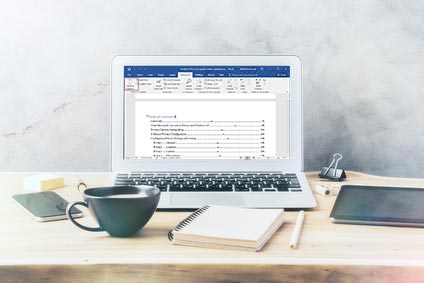
Inhaltsverzeichnis
- 1 Definition: Table of Contents
- 3 Everything for Your Thesis
- 5 Create in Microsoft Word
- 6 In a Nutshell
Definition: Table of Contents
The table of contents is an organized listing of your document’s chapters, sections and, often, figures, clearly labelled by page number. Readers should be able to look at your table of contents page and understand immediately how your paper is organized, enabling them to skip to any relevant section or sub-section. The table of contents should list all front matter, main content and back matter, including the headings and page numbers of all chapters and the bibliography . A good table of contents should be easy to read, accurately formatted and completed last so that it is 100% accurate. Although you can complete a table of contents manually, many word processing tools like Microsoft Word enable you to format your table of contents automatically.
When adding the finishing touches to your dissertation, the table of contents is one of the most crucial elements. It helps the reader navigate (like a map) through your argument and topic points. Adding a table of contents is simple and it can be inserted easily after you have finished writing your paper. In this guide, we look at the do’s and don’ts of a table of contents; this will help you process and format your dissertation in a professional way.
When adding the finishing touches to your dissertation, the table of contents is one of the most crucial elements. It helps the reader navigate (like a map) through your argument and topic points. Adding a table of contents is simple and can be inserted easily after you have finished writing your paper. In this guide, we look at the do’s and don’ts of a table of contents; this will help you process and format your dissertation in a professional way.
- ✓ Post a picture on Instagram
- ✓ Get the most likes on your picture
- ✓ Receive up to $300 cash back
What is a table of contents?
A table of contents is a list, usually on a page at the beginning of a piece of academic writing , which outlines the chapters or sections names with their corresponding page numbers. In addition to chapter names, it includes bullet points of the sub-chapter headings or subsection headings. It usually comes right after the title page of a research paper.
How do you write a table of contents
To write a table of contents, you first write the title or chapter names of your research paper in chronological order. Secondly, you write the subheadings or subtitles, if you have them in your paper. After that, you write the page numbers for the corresponding headings and subheadings. You can also very easily set up a table of contents in Microsoft Word.
Where do you put a table of contents?
The table of contents is found on a page right at the beginning of an academic writing project. It comes specifically after the title page and acknowledgements, but before the introductory page of a writing project. This position at the beginning of an academic piece of writing is universal for all academic projects.
What to include in a table of contents?
A sample table of contents includes the title of the paper at the very top, followed by the chapter names and subtitles in chronological order. At the end of each line, is the page number of the corresponding headings. Examples of chapter names can be: executive summary, introduction, project description, marketing plan, summary and conclusion. The abstract and acknowledgments are usually not included in the table of contents, however this could depend on the formatting that is required by your institution. Scroll down to see some examples.
How important is a table of contents?
A table of contents is very important at the beginning of a writing project for two important reasons. Firstly, it helps the reader easily locate contents of particular topics itemized as chapters or subtitles. Secondly, it helps the writer arrange their work and organize their thoughts so that important sections of an academic project are not left out. This has the extra effect of helping to manage the reader’s expectation of any academic essay or thesis right from the beginning.
Everything for Your Thesis
A table of contents is a crucial component of an academic thesis. Whether you’re completing a Bachelor’s or a postgraduate degree, the table of contents is a requirement for dissertation submissions. As a rule of thumb, your table of contents will usually come after your title page , abstract, acknowledgement or preface. Although it’s not necessary to include a reference to this front matter in your table of contents, different universities have different policies and guidelines.
Although the table of contents is best completed after you have finished your thesis, it’s a good idea to draw up a mock table of contents in the early stages of writing. This allows you to formulate a structure and think through your topic and how you are going to research, answer and make your argument. Think of this as a form of “reverse engineering”. Knowing how your chapters are going to be ordered and what topics or research questions are included in each will help immensely when it comes to your writing.
The table of contents is not just an academic formality, it allows your examiner to quickly get a feel for your topic and understand how your dissertation will be presented. An unclear or sloppy table of contents may even have an adverse effect on your grade because the dissertation is difficult to follow.
Examiners are readers, after all, and a dissertation is an exercise in producing an argument. A clear table of contents will give both a good impression and provide an accurate roadmap to make the examiner’s job easier and your argument more persuasive.
Your table of contents section will come after your acknowledgements and before your introduction. It includes a list of all your headers and their respective pages and will also contain a sub-section listing your tables, figures or illustrations (if you are using them). In general, your thesis can be ordered like this:
1. Title Page 2. Copyright / Statement of Originality 3. Abstract 4. Acknowledgement, Dedication and Preface (optional) 5. Table of Contents 6. List of Figures/Tables/Illustrations 7. Chapters 8. Appendices 9. Endnotes (depending on your formatting) 10. Bibliography / References
The formatting of your table of contents will depend on your academic field and thesis length. Some disciplines, like the sciences, have a methodical structure which includes recommended subheadings on methodology, data results, discussion and conclusion. Humanities subjects, on the other hand, are far more varied. Whichever discipline you are working in, you need to create an organized list of all chapters in their order of appearance, with chapter subheadings clearly labelled.
Sample table of contents for a short dissertation:
Abstract ………………………………………………………………………………………………….. ii Acknowledgements ………………………………………………………………………………………………….. iii Dedication ………………………………………………………………………………………………….. iv List of Tables ………………………………………………………………………………………………….. x List of Figures ………………………………………………………………………………………………….. xi Chapter 1: Introduction ………………………………………………………………………………………………….. 1 Chapter 2: Literature Survey ………………………………………………………………………………………………….. 13 Chapter 3: Methodology ………………………………………………………………………………………………….. 42 Chapter 4: Analysis ………………………………………………………………………………………………….. 100 Chapter 5: Conclusion ………………………………………………………………………………………………….. 129 Appendices ………………………………………………………………………………………………….. 169 References ………………………………………………………………………………………………….. 172
When producing a more significant and longer dissertation, say for a Master’s degree or even a PhD, your chapter descriptions should contain all subheadings. These are listed with the chapter number, followed by a decimal point and the subheading number.
Sample table of contents for a PhD dissertation:
Chapter 1 1.1 Introduction 1.2 Literature Review 1.3 Data 1.4 Findings 1.5 Conclusion
Chapter 2, and so on.
The key to writing a good table of contents is consistency and accuracy. You cannot list subheadings for one chapter and forget them for another. Subheadings are not always required but they can be very helpful if you are dealing with a detailed topic. The page numbers in the table of contents must match with the respective pages in your thesis or manuscript.
What’s more, chapter titles and subheading titles must match their corresponding pages. If your first chapter is called “Chapter 1: The Beginning”, it must be written as such on both the table of contents and first chapter page. So long as you remain both accurate and consistent, your table of contents will be perfect.
Create in Microsoft Word
Fortunately, the days of manually writing a contents page are over. You can still produce a contents page manually with Microsoft Word, but consider using their automatic feature to guarantee accuracy and save time.
To produce an automatically-generated table of contents, you must first work with heading styles. These can be found in the home tab under “Styles”. Select top-level headings (your chapter titles) and apply the Heading 1 style. This ensures that they will be formatted as main headings. Second-level headings (subheadings) can be applied with the Heading 2 style. This will place them underneath and within each main heading.
Once you have worked with heading styles, simply click on the “References” tab and select “Table of Contents”. This option will allow you to automatically produce a page with accurate page links to your document. To customize the format and style applied to your table of contents, select “Custom Table of Contents” at the bottom of the tab. Remember to update your table of contents by selecting the table and choosing “Update” from the drop-down menu. This will ensure that your headings, sub-headings and page numbers all add up.
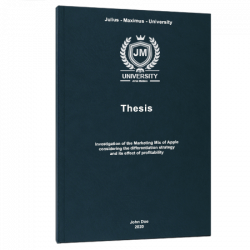
Thesis Printing & Binding
You are already done writing your thesis and need a high quality printing & binding service? Then you are right to choose BachelorPrint! Check out our 24-hour online printing service. For more information click the button below :
In a Nutshell
- The table of contents is a vital part of any academic thesis or extensive paper.
- It is an accurate map of your manuscript’s content – its headings, sub-headings and page numbers.
- It shows how you have divided your thesis into more manageable chunks through the use of chapters.
- By breaking apart your thesis into discrete sections, you make your argument both more persuasive and easier to follow.
- What’s more, your contents page should produce an accurate map of your thesis’ references, bibliography, illustrations and figures.
- It is an accurate map of the chapters, references, bibliography, illustrations and figures in your thesis.
We use cookies on our website. Some of them are essential, while others help us to improve this website and your experience.
- External Media
Individual Privacy Preferences
Cookie Details Privacy Policy Imprint
Here you will find an overview of all cookies used. You can give your consent to whole categories or display further information and select certain cookies.
Accept all Save
Essential cookies enable basic functions and are necessary for the proper function of the website.
Show Cookie Information Hide Cookie Information
| Name | |
|---|---|
| Anbieter | Eigentümer dieser Website, |
| Zweck | Speichert die Einstellungen der Besucher, die in der Cookie Box von Borlabs Cookie ausgewählt wurden. |
| Cookie Name | borlabs-cookie |
| Cookie Laufzeit | 1 Jahr |
| Name | |
|---|---|
| Anbieter | Bachelorprint |
| Zweck | Erkennt das Herkunftsland und leitet zur entsprechenden Sprachversion um. |
| Datenschutzerklärung | |
| Host(s) | ip-api.com |
| Cookie Name | georedirect |
| Cookie Laufzeit | 1 Jahr |
Statistics cookies collect information anonymously. This information helps us to understand how our visitors use our website.
| Akzeptieren | |
|---|---|
| Name | |
| Anbieter | Google Ireland Limited, Gordon House, Barrow Street, Dublin 4, Ireland |
| Zweck | Cookie von Google zur Steuerung der erweiterten Script- und Ereignisbehandlung. |
| Datenschutzerklärung | |
| Cookie Name | _ga,_gat,_gid |
| Cookie Laufzeit | 2 Jahre |
Content from video platforms and social media platforms is blocked by default. If External Media cookies are accepted, access to those contents no longer requires manual consent.
| Akzeptieren | |
|---|---|
| Name | |
| Anbieter | Meta Platforms Ireland Limited, 4 Grand Canal Square, Dublin 2, Ireland |
| Zweck | Wird verwendet, um Facebook-Inhalte zu entsperren. |
| Datenschutzerklärung | |
| Host(s) | .facebook.com |
| Akzeptieren | |
|---|---|
| Name | |
| Anbieter | Google Ireland Limited, Gordon House, Barrow Street, Dublin 4, Ireland |
| Zweck | Wird zum Entsperren von Google Maps-Inhalten verwendet. |
| Datenschutzerklärung | |
| Host(s) | .google.com |
| Cookie Name | NID |
| Cookie Laufzeit | 6 Monate |
| Akzeptieren | |
|---|---|
| Name | |
| Anbieter | Meta Platforms Ireland Limited, 4 Grand Canal Square, Dublin 2, Ireland |
| Zweck | Wird verwendet, um Instagram-Inhalte zu entsperren. |
| Datenschutzerklärung | |
| Host(s) | .instagram.com |
| Cookie Name | pigeon_state |
| Cookie Laufzeit | Sitzung |
| Akzeptieren | |
|---|---|
| Name | |
| Anbieter | Openstreetmap Foundation, St John’s Innovation Centre, Cowley Road, Cambridge CB4 0WS, United Kingdom |
| Zweck | Wird verwendet, um OpenStreetMap-Inhalte zu entsperren. |
| Datenschutzerklärung | |
| Host(s) | .openstreetmap.org |
| Cookie Name | _osm_location, _osm_session, _osm_totp_token, _osm_welcome, _pk_id., _pk_ref., _pk_ses., qos_token |
| Cookie Laufzeit | 1-10 Jahre |
| Akzeptieren | |
|---|---|
| Name | |
| Anbieter | Twitter International Company, One Cumberland Place, Fenian Street, Dublin 2, D02 AX07, Ireland |
| Zweck | Wird verwendet, um Twitter-Inhalte zu entsperren. |
| Datenschutzerklärung | |
| Host(s) | .twimg.com, .twitter.com |
| Cookie Name | __widgetsettings, local_storage_support_test |
| Cookie Laufzeit | Unbegrenzt |
| Akzeptieren | |
|---|---|
| Name | |
| Anbieter | Vimeo Inc., 555 West 18th Street, New York, New York 10011, USA |
| Zweck | Wird verwendet, um Vimeo-Inhalte zu entsperren. |
| Datenschutzerklärung | |
| Host(s) | player.vimeo.com |
| Cookie Name | vuid |
| Cookie Laufzeit | 2 Jahre |
| Akzeptieren | |
|---|---|
| Name | |
| Anbieter | Google Ireland Limited, Gordon House, Barrow Street, Dublin 4, Ireland |
| Zweck | Wird verwendet, um YouTube-Inhalte zu entsperren. |
| Datenschutzerklärung | |
| Host(s) | google.com |
| Cookie Name | NID |
| Cookie Laufzeit | 6 Monate |
Privacy Policy Imprint
- Discoveries
- Right Journal
- Journal Metrics
- Journal Fit
- Abbreviation
- In-Text Citations
- Bibliographies
- Writing an Article
- Peer Review Types
- Acknowledgements
- Withdrawing a Paper
- Form Letter
- ISO, ANSI, CFR
- Google Scholar
- Journal Manuscript Editing
- Research Manuscript Editing
Book Editing
- Manuscript Editing Services
Medical Editing
- Bioscience Editing
- Physical Science Editing
- PhD Thesis Editing Services
- PhD Editing
- Master’s Proofreading
- Bachelor’s Editing
- Dissertation Proofreading Services
- Best Dissertation Proofreaders
- Masters Dissertation Proofreading
- PhD Proofreaders
- Proofreading PhD Thesis Price
- Journal Article Editing
- Book Editing Service
- Editing and Proofreading Services
- Research Paper Editing
- Medical Manuscript Editing
- Academic Editing
- Social Sciences Editing
- Academic Proofreading
- PhD Theses Editing
- Dissertation Proofreading
- Proofreading Rates UK
- Medical Proofreading
- PhD Proofreading Services UK
- Academic Proofreading Services UK
Medical Editing Services
- Life Science Editing
- Biomedical Editing
- Environmental Science Editing
- Pharmaceutical Science Editing
- Economics Editing
- Psychology Editing
- Sociology Editing
- Archaeology Editing
- History Paper Editing
- Anthropology Editing
- Law Paper Editing
- Engineering Paper Editing
- Technical Paper Editing
- Philosophy Editing
- PhD Dissertation Proofreading
- Lektorat Englisch
- Akademisches Lektorat
- Lektorat Englisch Preise
- Wissenschaftliches Lektorat
- Lektorat Doktorarbeit
PhD Thesis Editing
- Thesis Proofreading Services
- PhD Thesis Proofreading
- Proofreading Thesis Cost
- Proofreading Thesis
- Thesis Editing Services
- Professional Thesis Editing
- Thesis Editing Cost
- Proofreading Dissertation
- Dissertation Proofreading Cost
- Dissertation Proofreader
- Correção de Artigos Científicos
- Correção de Trabalhos Academicos
- Serviços de Correção de Inglês
- Correção de Dissertação
- Correção de Textos Precos
- 定額 ネイティブチェック
- Copy Editing
- FREE Courses
- Revision en Ingles
- Revision de Textos en Ingles
- Revision de Tesis
- Revision Medica en Ingles
- Revision de Tesis Precio
- Revisão de Artigos Científicos
- Revisão de Trabalhos Academicos
- Serviços de Revisão de Inglês
- Revisão de Dissertação
- Revisão de Textos Precos
- Corrección de Textos en Ingles
- Corrección de Tesis
- Corrección de Tesis Precio
- Corrección Medica en Ingles
- Corrector ingles
Select Page
How To Write a Table of Contents for Academic Papers
Posted by Rene Tetzner | Mar 17, 2021 | How To Get Published | 0 |

How To Write a Table of Contents for Academic Papers Although every author begins a writing project with the best of intentions and an ideal outline in mind, it often proves difficult to stick to one’s initial plans as the text begins to unfold and its complexities grow in number and depth. Sometimes a document quickly exceeds the word limits for a project, and at others certain important aspects are neglected or turn out a good deal shorter than intended. Drafting a working table of contents for your writing project can provide an excellent tool for keeping your discussion on track and your text within length requirements as you write.
A working table of contents should begin with a title. This title may change as you draft your text, but a working title will help you focus your thoughts as you devise the headings and plan the content for the main parts, chapters, sections and subsections that should be added beneath it. All headings, whether numbered or not, should be formatted in effective and consistent ways that distinguish section levels and clearly indicate the overall structure of the text. These headings can also be altered as your writing advances, but they will provide an effective outline of what you need to discuss and the order in which you think the main topics should be presented. At this initial stage, it is also a good idea to write under each heading a brief summary of or rough notes about what you hope to include in that part of the document, and you can continue to add, adjust and move material around within and among the sections as your table of contents and ultimately your text progresses. Reminders of how long (measured in words, paragraphs or pages) the entire text and each of its parts should ideally be may also prove helpful.

Once you have your annotated table of contents drafted, it will serve as an informative list of both content and order that can be productively consulted as you write. Assuming you construct your working table of contents as a computer file in the same program you intend to use for writing the entire document, you can also use the table of contents as a template for composing the text as a whole, replacing your rough notes under each heading with the formal text as you draft it. This practice lends an immediate physical presence to the guidance provided by your table of contents because you are literally working within that outline, which can be especially wise if you tend to run on or become distracted by new ideas as you write.
Finally, your working table of contents can become your final table of contents if one is required for your project. If you would like to use the working table of contents in this way and are also using it as a template, be sure to rename the file and save a separate copy before you begin adding the formal text of your document. Then you can simply delete your summaries and rough notes from the original table of contents to make your final one, leaving only the headings, to which you can add relevant page numbers as required.

You might be interested in Services offered by Proof-Reading-Service.com
Journal editing.
Journal article editing services
PhD thesis editing services
Scientific Editing
Manuscript editing.
Manuscript editing services
Expert Editing
Expert editing for all papers
Research Editing
Research paper editing services
Professional book editing services
Related Posts

Choosing the Right Journal
September 10, 2021

Example of a Quantitative Research Paper
September 4, 2021

What Is a Good H-Index Required for an Academic Position?
September 3, 2021

Acknowledgements Example for an Academic Research Paper
September 1, 2021
Our Recent Posts

Our review ratings
- Examples of Research Paper Topics in Different Study Areas Score: 98%
- Dealing with Language Problems – Journal Editor’s Feedback Score: 95%
- Making Good Use of a Professional Proofreader Score: 92%
- How To Format Your Journal Paper Using Published Articles Score: 95%
- Journal Rejection as Inspiration for a New Perspective Score: 95%
Explore our Categories
- Abbreviation in Academic Writing (4)
- Career Advice for Academics (5)
- Dealing with Paper Rejection (11)
- Grammar in Academic Writing (5)
- Help with Peer Review (7)
- How To Get Published (146)
- Paper Writing Advice (17)
- Referencing & Bibliographies (16)
How to Write a Table of Contents for Different Formats With Examples
- Icon Calendar 18 May 2024
- Icon Page 984 words
- Icon Clock 6 min read
Rules that guide academic writing are specific to each paper format. However, some rules apply to all styles – APA, MLA, Chicago/Turabian, and Harvard. Basically, one of these rules is the inclusion of a Table of Contents (TOC) in an academic text, particularly long ones, like theses, dissertations, and research papers. When writing a TOC, students or researchers should observe some practices regardless of paper formats. Also, it includes writing the TOC on a new page after the title page, numbering the first-level and corresponding second-level headings, and indicating the page number of each entry. Hence, scholars need to learn how to write a table of contents in APA, MLA, Chicago/Turabian, and Harvard styles.
General Guidelines
When writing academic texts, such as theses, dissertations, and other research papers, students observe academic writing rules as applicable. Generally, the different paper formats – APA, MLA, Chicago/Turabian, and Harvard – have specific standards that students must follow in their writing. In this case, one of the rules is the inclusion of a Table of Contents (TOC) in the document. By definition, a TOC is a roadmap that scholars provide in their writing, outlining each portion of a paper. In other words, a TOC enables readers to locate specific information in documents or revisit favorite parts within written texts. Moreover, this part of academic papers provides readers with a preview of the paper’s contents.
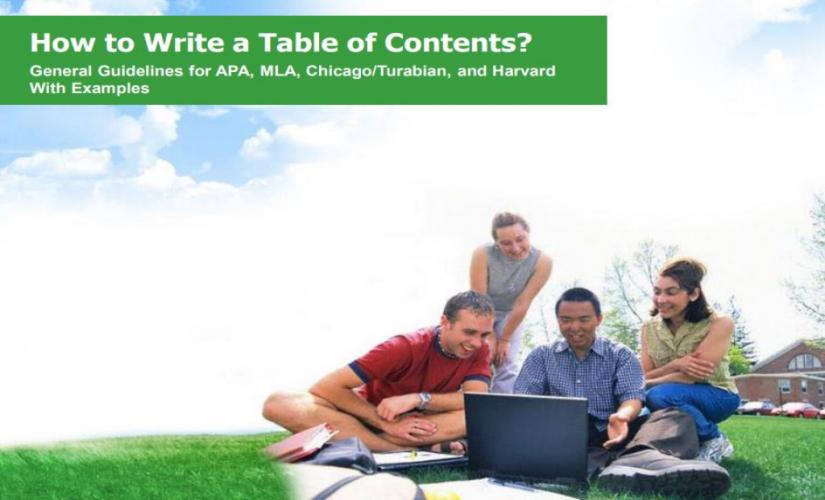
Difference Between a Table of Contents and an Outline
In essence, a TOC is a description of first-level headings (topics) and second-level headings (subtopics) within the paper’s body. For a longer document, writers may also include third-level titles to make the text palatable to read. Ideally, the length of papers determines the depth that authors go into detailing their writing in TOCs. Basically, this feature means that shorter texts may not require third-level headings. In contrast, an essay outline is a summary of the paper’s main ideas with a hierarchical or logical structuring of the content. Unlike a TOC that only lists headings and subheadings, outlines capture these headings and then describe the content briefly under each one. As such, an outline provides a more in-depth summary of essay papers compared to a TOC.
How to Write a Table of Contents in APA
When writing a TOC in the APA format, writers should capture all the headings in the paper – first-level, second-level, and even third-level. Besides this information, they should also include an abstract, references, and appendices. Notably, while a TOC in the APA style has an abstract, this section is not necessary for the other formats, like MLA, Chicago/Turabian, and Harvard. Hence, an example of a Table of Contents written in the APA format is indicated below:
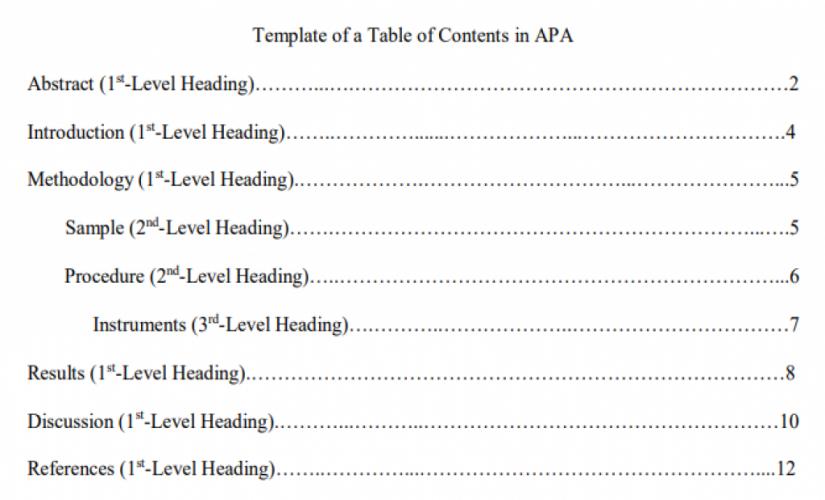
How to Write a Table of Contents in MLA
Unlike papers written in the APA style, MLA papers do not require a Table of Contents unless they are long enough. In this case, documents, like theses, dissertations, and books written in the MLA format should have a TOC. Even where a TOC is necessary, there is no specific method that a writer should use when writing it. In turn, the structure of the TOC is left to the writer’s discretion. However, when students have to include a TOC in their papers, the information they capture should be much more than what would appear in the APA paper. Hence, an example of writing a Table of Contents in MLA format is:
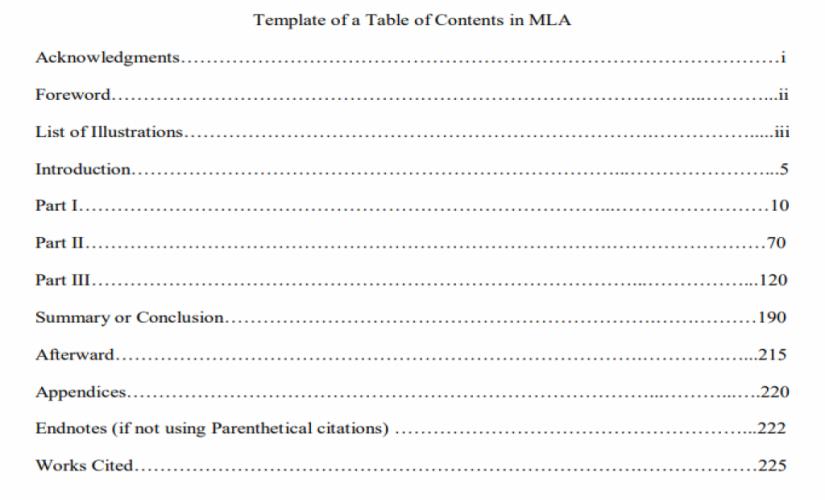
In the case of writing a research paper, an example of a Table of Contents should be:
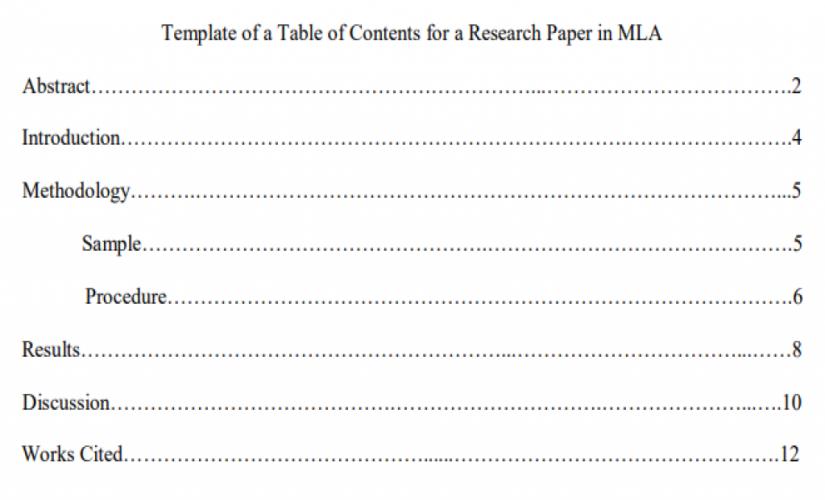
How to Write a Table of Contents in Chicago/Turabian
Like the MLA style, a Chicago/Turabian paper does not require writing a Table of Contents unless it is long enough. When a TOC is necessary, writers should capitalize on major headings. Additionally, authors do not need to add a row of periods (. . . . . . . .) between the heading entry and the page number. Moreover, the arrangement of the content should start with the first-level heading, then the second-level heading, and, finally, the third-level title, just like in the APA paper. In turn, all the information that precedes the introduction part should have lowercase Roman numerals. Also, the row of periods is only used for major headings. Hence, an example of writing a Table of Contents in a Chicago/Turabian paper is:
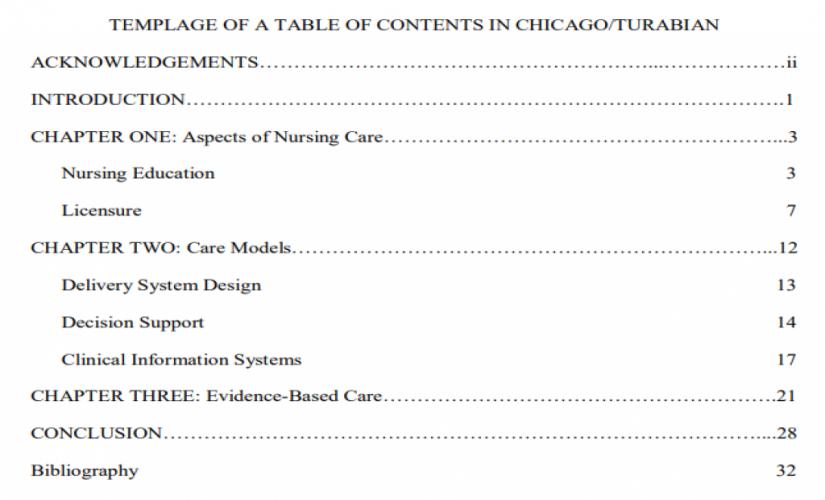
How to Write a Table of Contents in Harvard
Like in the other formats, writing a Table of Contents in the Harvard style is captured by having the title “Table of Contents” at the center of the page, in the first line. Basically, it comes after the title page and captures all the sections and subsections of Harvard papers. In other words, writers must indicate first-level headings in a numbered list. Also, scholars should align titles to the left side and capitalize them. In turn, if there is a need to show second-level headings, authors should list them under corresponding first-level headings by using bullet points. However, it is essential for students not to disrupt the numbering of first-level headings. Moreover, writers should align second-level headings to the left side and indent them by half an inch and capitalize on this content. Hence, an example of writing a Table of Contents in a Harvard paper should appear as below:
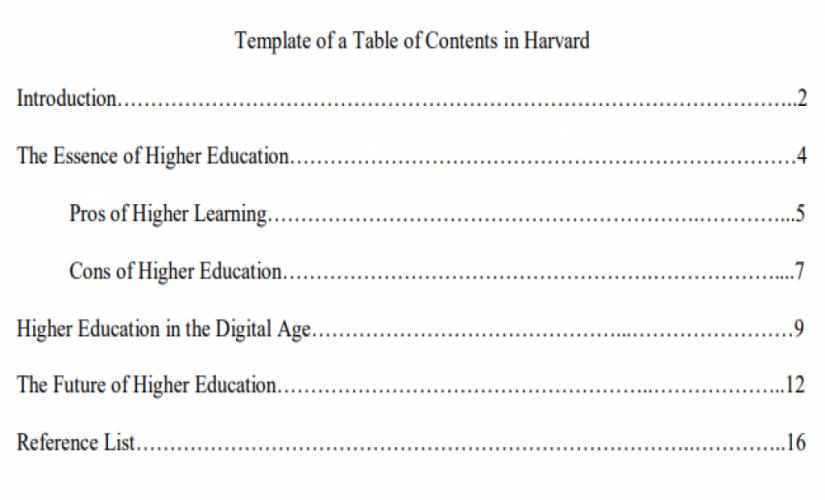
A Table of Content (TOC) is an essential component of an academic paper, particularly for long documents, like theses, dissertations, and research papers. When students are writing a TOC, they should be careful to follow the applicable format’s rules and standards. Regardless of the format, writers should master the following tips when writing a TOC:
- Write the TOC on a new page after the title page.
- Indicate first-level headings of the document in a numbered list.
- Indicate second-level headings under the corresponding first-level heading.
- If applicable, indicate third-level headings under the corresponding second-level heading.
- Write the page number for each heading.
- Put the content in a two-column table.
- Title the page with “Table of Contents.”
To Learn More, Read Relevant Articles
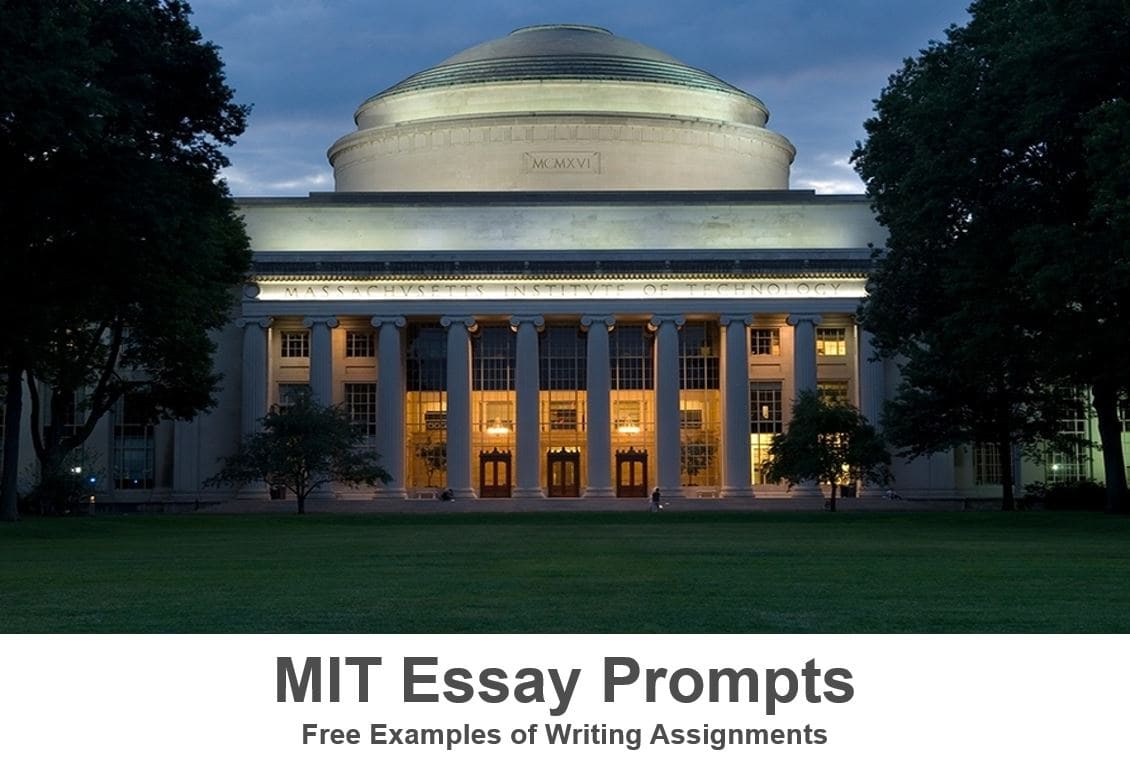
MIT Essay Prompts: Free Examples of Writing Assignments in 2024
- Icon Calendar 26 August 2020
- Icon Page 2576 words
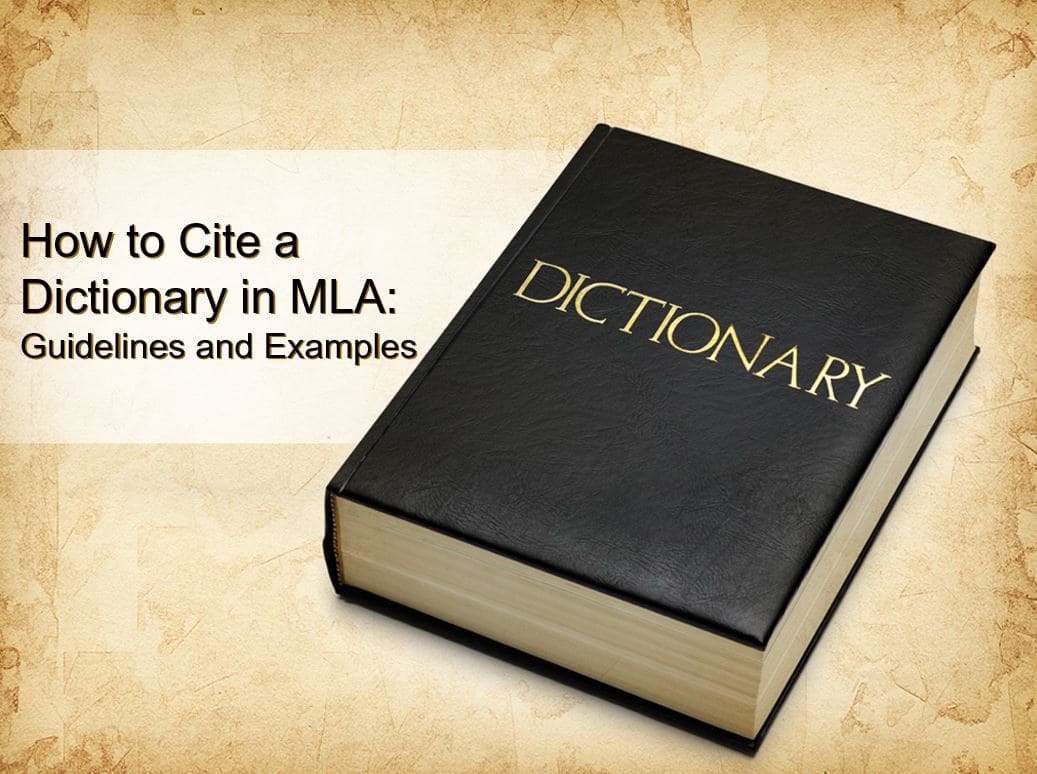
How to Cite a Dictionary in MLA 9: Guidelines and Examples
- Icon Calendar 24 August 2020
- Icon Page 1342 words
Table of Contents | Definition, Format & Examples
Daniel holds an M.S. Ed. in Secondary English Education from Duquesne University as well as a B.A. in English and Philosophy from Penn State University. He spent over a decade as a high school English teacher working with special education and advanced placement students. He continues to focus on helping the academic community as a freelance education writer and content developer.
Lindy has a M.Ed in TESOL with a Cross-Cultural concentration from Saint Mary's College of California. She has taught for 25 years at the secondary and university levels.
What is in a table of contents?
There are a variety of elements a table of contents could contain. Generally, they include chapter or section titles and their starting page numbers.
How do you format a table of contents?
The format of a table of contents varies depending upon the instructor and style guide. However, they all identify the chapters/sections within a paper and sequentially list them based on their order.
What is the purpose of the table of contents?
The table of contents mainly serves two purposes. The first purpose is to identify the paper's content; the second purpose is to identify the page number on which a section starts.
Table of Contents
What is a Table of Contents?
How to write and design a table of contents, exploring different formats of a table of contents, table of contents: examples, how to add tables of contents in microsoft word and google docs, lesson summary.
By definition, a table of contents provides an organized listing of what is included within fictional or non-fictional works; this can consist of chapter titles, sub-chapters, sections, and sub-sections listed sequentially by page number. They are included in works of literature, magazines, and more. A table of contents is listed at the beginning of the work, allowing a reader to identify the information structure and included content.
To unlock this lesson you must be a Study.com Member. Create your account

An error occurred trying to load this video.
Try refreshing the page, or contact customer support.
You must c C reate an account to continue watching
Register to view this lesson.
As a member, you'll also get unlimited access to over 88,000 lessons in math, English, science, history, and more. Plus, get practice tests, quizzes, and personalized coaching to help you succeed.
Get unlimited access to over 88,000 lessons.
Already registered? Log in here for access
Resources created by teachers for teachers.
I would definitely recommend Study.com to my colleagues. It’s like a teacher waved a magic wand and did the work for me. I feel like it’s a lifeline.
You're on a roll. Keep up the good work!
Just checking in. are you still watching.
- 0:00 Is a Table of Contents…
- 0:29 Basic Format
- 0:55 MLA (Modern Language…
- 1:57 APA (American…
- 2:15 Lesson Summary
When composing a table of contents, basic formatting includes the following:
- Font: Times New Font
- Font Size: 12-point
- Spacing: Double-spaced
- Alignment: Left aligned
- Length: No more than two pages
- Margins: 1"
- Headings: Written in title case
Concerning the content, most outlines include the following:
- Headings: All major headings and sub-headings
- Sections: Abstract, acknowledgments, preface, index, bibliography, appendices, lists of illustrations, graphs, tables, references, and endnotes (if instructed or when applicable)
- Page Numbers: All headings and sub-headings include the page number on which the section starts
There are multiple ways to format a table of contents. An instructor may request a table of contents written with a specific style and format. Two example table of contents formats commonly used in academia are APA Style and MLA Style
How to Format a Table of Contents in APA Style
While the American Psychological Association (APA) does not require a table of contents, instructors often request one to be included for theses or dissertations. Even though there are no specific formatting rules when using APA style, the following are preferred guidelines:
- Title: Include contents at the top of the page left-aligned and bolded
- Headings: All level 1 and level 2 headings should flush to the left margin; level 2 should be indented
- Capitalization: Headings should be in title case; follow APA guidelines regarding the capitalization of titles
- Page Numbers: Include the page numbers for both the headings and sub-headings
How to Format a Table of Contents in MLA Style
Papers using the Modern Language Associated (MLA) style guide typically only include a table of contents when the work has multiple chapters or sections, such as a dissertation or thesis. When formatting a table of contents for a thesis or dissertation using an MLA style guide, the following guidelines reflect MLA standards:
- Location: The placement of the table of contents should be between the abstract (a brief summary of the paper) and the introduction.
- Title: Include Contents, both centered and bolded, at the top of the page.
- Headings: All level 1 and level 2 headings should be included; level 2 should be indented; add an indent for each additional level (if needed)
- Capitalization: Headings should be in title case; follow MLA guidelines regarding the capitalization of titles
- Running Head: Include the page number in the top right-hand corner of the page(s)
- Graphic Elements: Requires a list of illustrations, tables, and charts in the table of contents
Two different formats of tables of contents are the single-level and multi-level versions.
Single-Level
A single-level table of contents identifies the individual sections or chapters without including any sub-headings and is most common with MLA-style papers.
Multi-Level
A multi-level table of contents generally provides headings and sub-headings and is mainly used with APA-style papers.
Adding a table of contents to a document is quite simple, as most word processing programs provide various templates to meet a writer's needs. While different software applications provide these templates, Microsoft Word and Google Docs are two of the most prevalent programs that can construct a table of contents.
Whether utilizing Microsoft Word or Google Docs, writers can manually insert their table of contents:
Step 1: Open a Word or Google Doc.
Step 2: Identify the page for the table of contents.
Step 3: Type each heading and sub-heading.
Step 4: A dotted line should link the heading or sub-heading title to its starting page number.
Step 5: Manually update sections and page numbers as needed.
Adding a Table of Contents in Microsoft Word
The following steps provide a breakdown as to how writers can have Microsoft Word automatically populate their table of contents:
Step 1: Open a Word document.
Step 2: Apply a heading style to each section of the paper to be included in the table of contents by highlighting the text and then choosing the desired heading in the Home tab under Styles; this will automatically add the information to the table of contents.
Step 3: Under Styles select Heading 1 for the main level and Heading 2 for sub-levels.
Step 4: At the top of the page, click on the References tab and select Table of Contents.
Step 5: Choose an automatic table style.
Step 6: Update as needed by clicking Update Table and choosing Update Entire Table.
Adding a Table of Contents in Google Docs
If using Google Docs, the following steps illustrate the automatic creation of a table of contents:
Step 1: Open Google Docs.
Step 2: Click the location in the document where the table of contents should be inserted.
Step 3: Click Insert and select Table of Contents.
Step 4: Apply a heading style to each section of the paper to be included in the table of contents by highlighting the text and then choosing the desired heading in the Format tab under Paragraph Styles; this will automatically add the information to the table of contents.
Step 5: Update as needed by clicking the table of contents in the body of the document and clicking the Update Table of Contents button, which looks like a typical refresh button.
While the inclusion of a table of contents may not always be required, there are times when they are needed based on the instructor's directions. If they ask for one, most will necessitate the writer to use either MLA or APA formats.
Overall, including a table of contents can benefit lengthier works, especially in theses or dissertations. It can help readers find chapters, sections, sub-sections, etc., to access the information quickly. It provides an overview of the work's organization and content to benefit those who need to access the information.
Video Transcript
Is a table of contents necessary .
A table of contents is like car insurance; it may not be used very often. However, it is extremely necessary to have at the beginning of a book, magazine, or any longer written work. A table of contents is an essential tool that helps readers find what they need in a reading by providing an overview or outline of exactly what is to come. Let's take a look at some different types of tables of contents and how they are formatted.
Basic Format
A basic table of contents highlights the topics covered in the writing and the page number on which they appear. The table of contents may give specific sections or chapters, depending on the writing. It can be useful to use descriptive headings so the reader can locate information easily. A basic table of contents may look like this:
Prologue ……………………………………………………………. 1
Chapter 1 …………………………………………………………… 2
Chapter 3 …………………………………………………………… 3
MLA (Modern Language Association) Format
A short essay or research paper written in MLA format requires no table of contents. However, if your written report, research paper, or other longer work is more than five pages, it is helpful to include a table of contents showing the page number where each specific section is located. It is similar to a road map for your reader and assists them with finding specific sections of your written document. The MLA format for the order of the information is:
A table of contents in MLA format may not include all the elements listed here, and that is fine. A more simplified version may include the introduction, body, conclusion, and works cited. Remember that in MLA format, a paper requires a list of illustrations and tables, which should also be listed on the table of contents page.
Here is an example of a table of contents in MLA format:
APA (American Psychological Association) Format
In APA format, there are no formatting rules. Most academic essays written in APA format do not require a table of contents. Rather, the table of contents is often a requirement from a course instructor. When creating a table of contents for an APA formatted paper, the basic sections of your paper should be included.
A table of contents , while often not required, is a useful part of any writing. It helps readers find the page numbers of specific topics, sections, or chapters. Most tables of contents follow one of the following formats: basic, MLA style, or APA style.
Basic tables of contents typically contain the names of the sections or chapters in the writing and the page numbers on which they are found. In MLA format, tables of contents should have broad section headings listed; however, these may vary depending on what is included in the writing. In APA format, there are no formatting rules for tables of contents; rather, they are usually required by a course instructor.
Unlock Your Education
See for yourself why 30 million people use study.com, become a study.com member and start learning now..
Already a member? Log In
Recommended Lessons and Courses for You
Related lessons, related courses, recommended lessons for you.

Table of Contents | Definition, Format & Examples Related Study Materials
- Related Topics
Browse by Courses
- Human Growth and Development Textbook
- Psychology 107: Life Span Developmental Psychology
- CLEP Human Growth and Development Prep
- Human Growth and Development: Help and Review
- UExcel Social Psychology: Study Guide & Test Prep
- Introduction to Social Psychology: Certificate Program
- Introduction to Psychology: Tutoring Solution
- UExcel Research Methods in Psychology: Study Guide & Test Prep
- Educational Psychology: Homework Help Resource
- Research Methods in Psychology: Certificate Program
- High School Psychology: Homeschool Curriculum
- High School Psychology: Credit Recovery
- Life Span Developmental Psychology: Help and Review
- Life Span Developmental Psychology: Homework Help Resource
- Introduction to Psychology: Certificate Program
Browse by Lessons
- Guilt in Psychology | Definition & Examples
- Executive Function Disorder: Definition, Symptoms & Treatment
- Multiple Disabilities | Characteristics, Prevalance & Causes
- Implicit Self-Esteem | Definition, Factors & Examples
- How to Read Body Language
- Micro Expression | Definition, Types & Examples
- Psychologist Dan Gilbert | Biography & Stumbling on Happiness
- Psychology of False Confessions: Causes, Consequences & Implications
- Relativist Fallacy | Overview, Arguments & Examples
- Williams v. Florida: Case Summary & Importance
- William Moulton Marston | Biography, Accomplishment & Career
- What Is Happiness? - Definition & Explanation
- Low Frustration Tolerance | Overview, Skills & Examples
- Convergence Theory in Psychology | Definition, Use & Examples
Create an account to start this course today Used by over 30 million students worldwide Create an account
Explore our library of over 88,000 lessons
- Foreign Language
- Social Science
- See All College Courses
- Common Core
- High School
- See All High School Courses
- College & Career Guidance Courses
- College Placement Exams
- Entrance Exams
- General Test Prep
- K-8 Courses
- Skills Courses
- Teacher Certification Exams
- See All Other Courses
- Create a Goal
- Create custom courses
- Get your questions answered
- PRO Courses Guides New Tech Help Pro Expert Videos About wikiHow Pro Upgrade Sign In
- EDIT Edit this Article
- EXPLORE Tech Help Pro About Us Random Article Quizzes Request a New Article Community Dashboard This Or That Game Popular Categories Arts and Entertainment Artwork Books Movies Computers and Electronics Computers Phone Skills Technology Hacks Health Men's Health Mental Health Women's Health Relationships Dating Love Relationship Issues Hobbies and Crafts Crafts Drawing Games Education & Communication Communication Skills Personal Development Studying Personal Care and Style Fashion Hair Care Personal Hygiene Youth Personal Care School Stuff Dating All Categories Arts and Entertainment Finance and Business Home and Garden Relationship Quizzes Cars & Other Vehicles Food and Entertaining Personal Care and Style Sports and Fitness Computers and Electronics Health Pets and Animals Travel Education & Communication Hobbies and Crafts Philosophy and Religion Work World Family Life Holidays and Traditions Relationships Youth
- Browse Articles
- Learn Something New
- Quizzes Hot
- This Or That Game
- Train Your Brain
- Explore More
- Support wikiHow
- About wikiHow
- Log in / Sign up
- Education and Communications
- Technical Writing
How to Write a Table of Contents
Last Updated: February 16, 2024 Fact Checked
This article was co-authored by Stephanie Wong Ken, MFA . Stephanie Wong Ken is a writer based in Canada. Stephanie's writing has appeared in Joyland, Catapult, Pithead Chapel, Cosmonaut's Avenue, and other publications. She holds an MFA in Fiction and Creative Writing from Portland State University. This article has been fact-checked, ensuring the accuracy of any cited facts and confirming the authority of its sources. This article has been viewed 1,053,396 times.
The Table of Contents in a document acts as a map for the reader, making it easier for them to find information in the document based on title and page number. A good Table of Contents should be organized, easy to read and simple to use. You can write a Table of Contents manually on your computer or have a word processing tool create it for you. Make sure the Table of Contents is formatted properly in your final document so it is as accurate and accessible as possible.
Sample Tables of Contents

Creating the Table of Contents on a Word Processor

- The Table of Contents should be on its own page. Do not include the introduction or a dedication on the same page as the Table of Contents.

- For example, you may write down main headings like, “Introduction,” “Case Study 1,” or “Conclusion.”

- For example, under the main heading “Introduction” you may write the subheading, “Themes and Concepts.” Or under the main heading “Conclusion” you may write, “Final Analysis.”
- You can also include sub-subheadings underneath the subheadings, if applicable. For example, under the subheading “Themes and Concepts” you may have the sub-subheading, “Identity.”
- Some papers do not have subheadings at all, only main headings. If this is the case, skip this step.

- For example, if the “Introduction” section begins on page 1, you will attach “page 1” to the Introduction heading. If the “Conclusion” section begins on page 45, attach “page 45” to the Conclusion heading.

- Check that the subheadings are located underneath the correct headings, indented to the right.
- Make sure there are page numbers for the subheadings listed as well.
- You can center the content in the table using the table options if you want the content to appear a few spaces away from the lines of the table. You can also leave the content indented to the left if you'd prefer.

- You can put the title above the table or in a separate row on the top of the rest of the content.
Using a Word Processing Tool

- You should also confirm the page numbers are correct in the document. Each page should be numbered in order. Having the correct page numbers will ensure the Table of Contents is created correctly when you use the word processing tool.

- If there are subheadings in your document, label them “Heading 2.” Highlight each subheading and click on “Heading 2” in the Styles tab.
- If there are sub-subheadings in your document, label them “Heading 3.” Highlight each subheading and click on “Heading 3” in the Styles tab.
- The text and font for each main heading may change based on the settings for “Heading 1,” “Heading 2,” and “Heading 3.” You can choose your preferred text and font for each main heading so they appear as you like in the Table of Contents.

- You can choose the built-in Table of Content options, where the tool will automatically choose a font size and style for you.
- You can also go for from a list of custom Table of Contents, where you choose the font color and size based on your preferences.
Polishing the Table of Contents

- You should also check the subheadings or sub-subheadings in the Table of Contents, if applicable, to ensure they match those in the document.

- If you created the Table of Contents manually, do this by going in and adjusting the headings and/or the page numbers when they change.
- If you created the Table of Contents with a word processing tool, update it by clicking the Update option by the Table of Contents option on the Reference tab. You can side clicking on the Table of Contents and choosing “update” that way.
Community Q&A
You Might Also Like

- ↑ https://edu.gcfglobal.org/en/word-tips/how-to-create-a-table-of-contents-in-word/1/#
- ↑ https://examples.yourdictionary.com/reference/examples/table-of-content-examples.html
- ↑ http://bitesizebio.com/21549/using-word-to-write-your-thesis-making-a-table-of-contents-inserting-captions-and-cross-referencing/
- ↑ https://guides.lib.umich.edu/c.php?g=283073&p=1886010
- ↑ https://nsufl.libguides.com/c.php?g=413851&p=2820026
About This Article

To write a table of contents, open a new document and list the major headings, titles, or chapters of the project in chronological order. Next, insert subheadings or subtopics if your project has those. Fill in the page number where each heading starts, then format the content in a table with 2 columns. Place the headings and subheadings in order in the first column, then put the page numbers in the second column. Don't forget to add a "Table of Contents" title at the top of the document! To learn more about polishing your Table of Contents, read on! Did this summary help you? Yes No
- Send fan mail to authors
Reader Success Stories
Mar 22, 2017
Did this article help you?
Mar 3, 2022
Feb 1, 2018

Featured Articles

Trending Articles

Watch Articles

- Terms of Use
- Privacy Policy
- Do Not Sell or Share My Info
- Not Selling Info
wikiHow Tech Help Pro:
Develop the tech skills you need for work and life
Skip navigation

World Leaders in Research-Based User Experience
Table of contents: the ultimate design guide.

October 6, 2023 2023-10-06
- Email article
- Share on LinkedIn
- Share on Twitter
The table of contents has been a standard feature in book publication for centuries, helping readers locate specific chapters by providing an exact page number for each section. With the advent of the digital age, traditional printed tables of contents were adapted to digital formats. Today, they are widely used on websites, in ebooks, and in other digital interfaces to organize information and enable easy navigation.

In This Article:
Considerations for table-of-contents design, placement considerations, styling considerations, best practices for tables of contents.
Definition: A table of contents is an ordered list of clickable headings corresponding to the content sections on the page. It allows users to navigate directly to any of the sections on the same page.
This article provides comprehensive guidance on effective table-of-contents design by discussing its benefits, different placement and styling considerations, best practices, and common table-of-contents patterns.

The benefits of using a table of contents on the page include:
- Scannable overview of the page
- Direct access to specific sections
- Increased discoverability of bottom content
- Ability to share specific page sections
- Increased discoverability on the search-engine-results page
Scannable Overview of the Page
A table of contents allows users to understand what the page has to offer without delving into details. It helps them form a mental model of the page and quickly determine whether the page content satisfies their information needs .
Direct Access to Specific Sections
Each heading in a table of contents is linked to a part of the page , allowing users to jump to sections of interest without having to scroll through irrelevant content.
Increased Discoverability of Bottom Content
Decades of research consistently indicate that people dedicate more attention to the top of the page . Thus, content at the bottom of a long page often suffers from low engagement. A table of contents increases the discoverability of the content that is low on the page.
Ability to Share Specific Page Sections
Each section included in the table of contents has a unique fragmented identifier in its URL, allowing users to precisely share specific sections of the page.

Increased Discoverability on the Search-Engine-Results Page
The search algorithm can detect the section headings and display them as site links , and a table of contents may increase the likelihood of this happening. Because users can get an overview of the page content before accessing the page , the clickthrough rate might increase as a result.

When deciding what design to use for your table of contents, there are two kinds of considerations:
- In rail or in the main body of the text
- At the top of the page or lower in the body
- Sticky or nonsticky
- Vertical vs. horizontal vs. multicolumn layout

Rail vs. Body
There are 3 placement options for tables of contents:

|
|
|
|
One of the most common locations to place a table of contents is within the main body of the page. Frequently, this placement is utilized when the left or right rail is otherwise occupied, such as by local navigation , or not available (for example, on mobile or 1-column layouts).

In addition to the obvious visibility benefits of placing the table of contents directly above or within the article itself, this placement approach is also the easiest to implement on mobile.

A factor that is necessary to consider with main-body placement is whether the table of contents should be placed at the very top of the page, or further down within the body of the text ( see below ).
Another common approach is to place the table of contents within a rail on the left side of the page.

This approach provides a visual separation between the main content of the page and the navigational table of contents and allows readers quicker access to the article text.
The left rail placement does lead to some complications when it comes to mobile implementation, as mobile design typically does not allow for a left rail at all. Some common mobile implementations of left-rail table of contents placement include:
✅ Move the table of contents to the main body
The simplest solution is to move the table of contents to the main body of the article. One danger of this strategy is that even a short, 1-paragraph introduction to the page can push the table of contents below the fold .
✅ Convert table-of-contents headings into accordions
This solution uses accordions instead of links to create a table of content, by collapsing each section into an accordion .

⚠️ Convert to a sticky, collapsible table of contents
Some designers choose to collapse the table of contents and make it sticky to the top of the page. In some implementations, this table of contents only appears after scrolling down to a certain point on the page.
However, visibility is often a concern. In testing, many users failed to notice the sticky table of contents in these implementations.
While tables of contents placed in a left rail or main body are most common, right-rail tables of contents are still relatively frequent. Like main-body tables of contents, this approach is particularly appealing when the left rail is occupied by local navigation.

Like left-rail designs, right-rail tables of contents will not translate well to smaller screens or 1-column layouts.
The primary concern with right-rail tables of contents is visibility. Web users have trained themselves to ignore content that resembles advertising in any way, which includes any content placed in a right rail.
A simple, nongraphical design can prevent right-rail blindness.

Additionally, avoid confusion with local navigation or related-content links by including a clear, relevant header, such as Table of Contents or On This Page .
Sticky vs. Nonsticky
Another consideration when designing a table of contents is whether it should be fixed ( sticky ) to the top of the page.
Sticky Tables of Contents
A sticky table of contents will not be lost after the user scrolls down the page. When the table of contents is in a left or right rail, making it sticky is easy, as the table of contents can remain in the same format (typically, a vertical stack of links).
To increase the usability and benefit of a sticky table of contents, consider highlighting the current section in the table of contents to show users where they are in the article as they scroll down.
Benefits of highlighting the current section include:
- Users get feedback on scrolling progress and learn where they are on the page.
- Animation attracts attention , increasing the discoverability of the table of contents. Additionally, subtle animation can create delightful microinteractions .
Nonsticky Tables of Contents
When dealing with a table of contents placed in the main body of the article, consider a nonsticky implementation. Sticky tables of contents in the main body can lead to a number of complications as they may compete with the site’s global navigation.
While most main nonsticky main-body tables of contents are stacked vertically, designers of sticky main body tables of contents tend to opt instead for a horizontal display of links. When this horizontal bar of links is stuck to the top of the page, it isn’t hard to understand why so many users confuse them with global navigation.
In both of the examples displayed above, the user is likely to confuse the table of contents for either a global or local navigation. As a result, we recommend a nonsticky implementation of a table of contents when placed within the main body .
|
|
|
| In a left or right rail | …sticky. |
| In the main body | …nonsticky. |
At the Top of the Page vs. In the Body of the Text
Tables of contents are almost always found near the top of the page. Typically, they sit below the heading but above the main body of the article. This placement is the safe choice. However, sometimes tables of contents are embedded within the body of the article itself, sometimes following a brief introduction. This implementation comes with risks, which we outline in the sections below.
At the Top of the Page
Most often, tables of contents are located just below the heading or a short content brief, with some visual separation differentiating it from the body of the text.

This is a time-tested pattern that brings with it some advantages.
- The table of contents will typically sit above the fold, allowing users to easily scan the contents of the page.
- The table of contents is less likely to be confused with other page elements, such as body text, local navigation, or other types of links.
In the Body of the Text
A table of contents placed further down the page within the page body is less discoverable, as it may require scrolling to get to it. As a result, it is less likely to function as an effective page overview. Additionally, when blended into the text body, the anchor links of the table of contents can easily be mistaken for links leading to other pages.

There are a few strategies designers can employ to avoid this potential link confusion:

Vertical Layout vs. Horizontal Layout vs. Multicolumn Layout
Depending on the makeup of the table of contents and the various links it contains, there are various potential layouts for how to style the table of contents itself.

Vertical Layout
The most common layout for tables of contents is a single-column vertical format. This format is most advantageous when you have few topics with longer headings.
|
|
|

Horizontal Layout
Tables of contents can also be formatted in a horizontal layout, to save vertical space. This is best saved for instances with fewer topics and shorter headings.

Multicolumn Layout
This is a less common design pattern that, nonetheless, offers the best of both worlds: efficient use of screen space and scannability. This approach is best suited for instances with many listed topics.

Visualizing In-page Links
Our research has indicated that web users demonstrate increased familiarity with in-page links . Nevertheless, it remains critical to provide sufficient signifiers of clickability in order to maximize the affordance of the links. In other words, all the standard best practices for link visualization apply here. For example, table-of-contents links should be colored and underlined, as in the below example from the National Institute on Aging.

On the other hand, if links lack sufficient signifiers, they are likely to be overlooked.

Additionally, misuse of signifiers can cause other forms of confusion, as in the example below.

Smooth-Scrolling Effects
A final styling question to consider is how to facilitate the movement of the page from one section to another after the user clicks on a table-of-contents link. Traditionally, the page would instantly jump the user down the page, providing instant access to the desired content. An alternative approach employs smooth scrolling from one point on the page to another, which can create a seamless experience by showing continuity in transition . This design also eliminates any possible confusion that the user may have been taken to a new page.
Below are some best practices to follow when designing a table of contents:
- Use a clear label for the table of contents.
- Avoid discrepancies in link labels.
- Make headings scannable.
- Do not include external links in the table of contents.
- Do not skip content headings (even if they are above the fold).
- Include back-to-top links.
- Ensure consistency across all the tables of contents.
Use a Clear Label for the Table of Contents
As in-page links often share a similar visual style with links that direct users to external pages, it becomes essential to distinguish the table-of-contents section from other links present on the page. Appropriately labeling the section helps clarify how the links will function. It can also provide context for screen-reader users and users who are exposed to a limited amount of content (e.g., screen magnifier users and users on a small screen)
Table of Content , Contents , On This Page , and In This Article are informative and predictable labels for a table of contents. Tell Me More , on the other hand, has poor information scent , and the links in the section can be mistaken for links to related content.

Avoid Discrepancies in Link Labels
Just like any other links existing on the web, the links listed under the table of contents are promises to keep . They should match the section headings they are leading to, to reassure users that they have arrived at the right section on the page. Discrepancies in wording force users to analyze and compare two highly similar headings, adding unnecessary cognitive load .

Make Headings Scannable
The headings in the table of contents should be succinct and easy to scan, allowing users to quickly grasp the essence of the page. A long list of lengthy headings can create a daunting wall of text. Going through a long list of distinct links is like reading a huge paragraph, with each sentence conveying a separate message.

Do Not Include External Links in the Table of Contents
Users expect the links in the table of contents to behave consistently. Mixing external and in-page links in the list will break users’ mental models and cause confusion.
Do Not Skip Content Headings (even if they are above the fold)
A table of contents acts as a comprehensive overview of the page. Leaving out sections or only displaying the sections below the fold can lead to an incomplete understanding of the page content and cause confusion.

Include Back-to-Top Links
When including a table of contents on a long page, consider whether users will access other sections of the page and how they will navigate after finishing the section. Will they keep reading? Or will they want to jump to a different section? Consider providing a back-to-top link to help users return to the top, especially when you have a long page with a nonsticky table of contents.

Ensure Consistency Across All the Tables of Contents
The style and format of the table of contents should be consistent across the website to match users’ expectations. A website without internal consistency forces users to relearn the pattern on each new page, distracting them from accomplishing their intended goals.

A table of contents provides a helpful page overview and facilitates in-page navigation for content pages. A thoughtful implementation should take into consideration different placement and styling options. By carefully weighing the benefits and tradeoffs of each option, you can create table of contents designs that maximize usability and impact.
Free Downloads
Related courses, application design for web and desktop.
Components, design patterns, workflows, and ways of interacting with complex data
Interaction
Design Systems and Pattern Libraries
Increase design quality, consistency, and efficiency
Designing Complex Apps for Specialized Domains
Create and evaluate applications for advanced decision making, complicated workflows, and complex domains
Related Topics
- Interaction Design Interaction Design
- Design Patterns
Learn More:

Sarah Gibbons · 3 min

Why Microinteractions Are Important for UX
Alita Joyce · 3 min

Why Interaction Cost Matters to UX
Raluca Budiu · 2 min
Related Articles:
Scrolljacking 101
Sara Ramaswamy · 10 min
Accordions on Desktop: When and How to Use
Huei-Hsin Wang · 10 min
Using Imagery in Visual Design
Rachel Krause · 6 min
AI-Powered Tools for UX Research: Issues and Limitations
Feifei Liu and Kate Moran · 9 min
Designing Empty States in Complex Applications: 3 Guidelines
Kate Kaplan · 7 min
Web UX: Study Guide
Huei-Hsin Wang · 11 min
8 Key Elements of a Research Paper Structure + Free Template (2024)
.webp)
Table of contents

Brinda Gulati
Welcome to the twilight zone of research writing. You’ve got your thesis statement and research evidence, and before you write the first draft, you need a wireframe — a structure on which your research paper can stand tall.
When you’re looking to share your research with the wider scientific community, your discoveries and breakthroughs are important, yes. But what’s more important is that you’re able to communicate your research in an accessible format. For this, you need to publish your paper in journals. And to have your research published in a journal, you need to know how to structure a research paper.
Here, you’ll find a template of a research paper structure, a section-by-section breakdown of the eight structural elements, and actionable insights from three published researchers.
Let’s begin!
Why is the Structure of a Research Paper Important?
A research paper built on a solid structure is the literary equivalent of calcium supplements for weak bones.
Richard Smith of BMJ says, “...no amount of clever language can compensate for a weak structure."
There’s space for your voice and creativity in your research, but without a structure, your paper is as good as a beached whale — stranded and bloated.
A well-structured research paper:
- Communicates your credibility as a student scholar in the wider academic community.
- Facilitates accessibility for readers who may not be in your field but are interested in your research.
- Promotes clear communication between disciplines, thereby eliminating “concept transfer” as a rate-limiting step in scientific cross-pollination.
- Increases your chances of getting published!
Research Paper Structure Template
.webp)
Why Was My Research Paper Rejected?
A desk rejection hurts — sometimes more than stubbing your pinky toe against a table.
Oftentimes, journals will reject your research paper before sending it off for peer review if the architecture of your manuscript is shoddy.
The JAMA Internal Medicine , for example, rejected 78% of the manuscripts it received in 2017 without review. Among the top 10 reasons? Poor presentation and poor English . (We’ve got fixes for both here, don’t you worry.)
5 Common Mistakes in a Research Paper Structure
- Choppy transitions : Missing or abrupt transitions between sections disrupt the flow of your paper. Read our guide on transition words here.
- Long headings : Long headings can take away from your main points. Be concise and informative, using parallel structure throughout.
- Disjointed thoughts : Make sure your paragraphs flow logically from one another and support your central point.
- Misformatting : An inconsistent or incorrect layout can make your paper look unprofessional and hard to read. For font, spacing, margins, and section headings, strictly follow your target journal's guidelines.
- Disordered floating elements : Ill-placed and unlabeled tables, figures, and appendices can disrupt your paper's structure. Label, caption, and reference all floating elements in the main text.
What Is the Structure of a Research Paper?
The structure of a research paper closely resembles the shape of a diamond flowing from the general ➞ specific ➞ general.
We’ll follow the IMRaD ( I ntroduction , M ethods , R esults , and D iscussion) format within the overarching “context-content-conclusion” approach:
➞ The context sets the stage for the paper where you tell your readers, “This is what we already know, and here’s why my research matters.”
➞ The content is the meat of the paper where you present your methods, results, and discussion. This is the IMRad (Introduction, Methods, Results, and Discussion) format — the most popular way to organize the body of a research paper.
➞ The conclusion is where you bring it home — “Here’s what we’ve learned, and here’s where it plays out in the grand scheme of things.”
Now, let’s see what this means section by section.
1. Research Paper Title
A research paper title is read first, and read the most.
The title serves two purposes: informing readers and attracting attention . Therefore, your research paper title should be clear, descriptive, and concise . If you can, avoid technical jargon and abbreviations. Your goal is to get as many readers as possible.
In fact, research articles with shorter titles describing the results are cited more often .
An impactful title is usually 10 words long, plus or minus three words.
For example:
- "Mortality in Puerto Rico after Hurricane Maria" (word count = 7)
- “A Review of Practical Techniques For the Diagnosis of Malaria” (word count = 10)
2. Research Paper Abstract
In an abstract, you have to answer the two whats :
- What has been done?
- What are the main findings?
The abstract is the elevator pitch for your research. Is your paper worth reading? Convince the reader here.

✏️ NOTE : According to different journals’ guidelines, sometimes the title page and abstract section are on the same page.
An abstract ranges from 200-300 words and doubles down on the relevance and significance of your research. Succinctly.
This is your chance to make a second first impression.
If you’re stuck with a blob of text and can’t seem to cut it down, a smart AI elf like Wordtune can help you write a concise abstract! The AI research assistant also offers suggestions for improved clarity and grammar so your elevator pitch doesn’t fall by the wayside.

Get Wordtune for free > Get Wordtune for free >
3. Introduction Section
What does it do.
Asks the central research question.
Pre-Writing Questions For the Introduction Section
The introduction section of your research paper explains the scope, context, and importance of your project.
I talked to Swagatama Mukherjee , a published researcher and graduate student in Neuro-Oncology studying Glioblastoma Progression. For the Introduction, she says, focus on answering three key questions:
- What isn’t known in the field?
- How is that knowledge gap holding us back?
- How does your research focus on answering this problem?
When Should You Write It?
Write it last. As you go along filling in the body of your research paper, you may find that the writing is evolving in a different direction than when you first started.
Organizing the Introduction
Visualize the introduction as an upside-down triangle when considering the overall outline of this section. You'll need to give a broad introduction to the topic, provide background information, and then narrow it down to specific research. Finally, you'll need a focused research question, hypothesis, or thesis statement. The move is from general ➞ specific.
✨️ BONUS TIP: Use the famous CARS model by John Swales to nail this upside-down triangle.
4. methods section.
Describes what was done to answer the research question, and how.
Write it first . Just list everything you’ve done, and go from there. How did you assign participants into groups? What kind of questionnaires have you used? How did you analyze your data?
Write as if the reader were following an instruction manual on how to duplicate your research methodology to the letter.
Organizing the Methods Section
Here, you’re telling the story of your research.
Write in as much detail as possible, and in the chronological order of the experiments. Follow the order of the results, so your readers can track the gradual development of your research. Use headings and subheadings to visually format the section.

This skeleton isn’t set in stone. The exact headings will be determined by your field of study and the journal you’re submitting to.
✨️ BONUS TIP : Drowning in research? Ask Wordtune to summarize your PDFs for you!
5. results section .
Reports the findings of your study in connection to your research question.
Write the section only after you've written a draft of your Methods section, and before the Discussion.
This section is the star of your research paper. But don't get carried away just yet. Focus on factual, unbiased information only. Tell the reader how you're going to change the world in the next section. The Results section is strictly a no-opinions zone.
How To Organize Your Results
A tried-and-true structure for presenting your findings is to outline your results based on the research questions outlined in the figures.
Whenever you address a research question, include the data that directly relates to that question.
What does this mean? Let’s look at an example:
Here's a sample research question:
How does the use of social media affect the academic performance of college students?
Make a statement based on the data:
College students who spent more than 3 hours per day on social media had significantly lower GPAs compared to those who spent less than 1 hour per day (M=2.8 vs. M=3.4; see Fig. 2).
You can elaborate on this finding with secondary information:
The negative impact of social media use on academic performance was more pronounced among freshmen and sophomores compared to juniors and seniors ((F>25), (S>20), (J>15), and (Sr>10); see Fig. 4).
Finally, caption your figures in the same way — use the data and your research question to construct contextual phrases. The phrases should give your readers a framework for understanding the data:
Figure 4. Percentage of college students reporting a negative impact of social media on academic performance, by year in school.
Dos and Don’ts For The Results Section

✔️ Related : How to Write a Research Paper (+ Free AI Research Paper Writer)
6. discussion section.
Explains the importance and implications of your findings, both in your specific area of research, as well as in a broader context.
Pre-Writing Questions For the Discussion Section
- What is the relationship between these results and the original question in the Introduction section?
- How do your results compare with those of previous research? Are they supportive, extending, or contradictory to existing knowledge?
- What is the potential impact of your findings on theory, practice, or policy in your field?
- Are there any strengths or weaknesses in your study design, methods, or analysis? Can these factors affect how you interpret your results?
- Based on your findings, what are the next steps or directions for research? Have you got any new questions or hypotheses?
Before the Introduction section, and after the Results section.
Based on the pre-writing questions, five main elements can help you structure your Discussion section paragraph by paragraph:
- Summary : Restate your research question/problem and summarize your major findings.
- Interpretations : Identify patterns, contextualize your findings, explain unexpected results, and discuss if and how your results satisfied your hypotheses.
- Implications: Explore if your findings challenge or support existing research, share new insights, and discuss the consequences in theory or practice.
- Limitations : Acknowledge what your results couldn’t achieve because of research design or methodological choices.
- Recommendations : Give concrete ideas about how further research can be conducted to explore new avenues in your field of study.
Dos and Don’ts For the Discussion Section

Aritra Chatterjee , a licensed clinical psychologist and published mental health researcher, advises, “If your findings are not what you expected, disclose this honestly. That’s what good research is about.”
7. Acknowledgments
Expresses gratitude to mentors, colleagues, and funding sources who’ve helped your research.
Write this section after all the parts of IMRaD are done to reflect on your research journey without getting distracted midway.
After a lot of scientific writing, you might get stumped trying to write a few lines to say thanks. Don’t let this be the reason for a late or no-submission.
Wordtune can make a rough draft for you.

All you then have to do is edit the AI-generated content to suit your voice, and replace any text placeholders as needed:

8. References
Lists all the works/sources used in your research with proper citations.
The two most important aspects of referencing are:
- Following the correct format; and
- Properly citing the sources.
Keep a working document of the works you’ve referenced as you go along, but leave the finishing touches for last after you’ve completed the body of your research paper — the IMRaD.
Tips For Writing the References Section
The error rate of references in several scientific disciplines is 25%-54% .
Don’t want to be a part of this statistic? We got you.
- Choose quality over quantity : While it's tempting to pad your bibliography to seem more scholarly, this is a rookie mistake. Samantha Summers , a museum professional based in Canada, is a published researcher in Medieval History and Critical Philanthropy studies. According to her, “Adding in a citation just to lengthen your bibliography and without engaging deeply with the cited work doesn’t make for good writing.” We ought to listen to her advice — she has three Master’s degrees to her name for a reason.
- Select the correct referencing guide : Always cross-check with your chosen journal’s or institution’s preference for either Harvard, MLA, APA, Chicago, or IEEE.
- Include recent studies and research : Aim to cite academically ripe sources — not overripe. Research from the past half-decade or so is ideal, whereas studies from the 80s or 90s run a higher risk of being stale.
- Use a reliable reference manager software : Swagatama recommends several free resources that have helped her get her research organized and published — Zotero and Mendeley are top contenders, followed by EndNote .
By the end, your References section will look something like this:

Ready, Get, Set, Publish!
Dust yourself off, we've made it out of the twilight zone. You’ve now got the diamond of the structure of a research paper — the IMRaD format within the “context-content-conclusion” model.
Keep this structure handy as you fill in the bones of your research paper. And if you’re stuck staring at a blinking cursor, fresh out of brain juice?
An AI-powered writing assistant like Wordtune can help you polish your diamond, craft great abstracts, and speed through drafts!
You've got this.
Share This Article:
.webp)
Why Little Words Matter: Write Microcopy for Digital Products with AI (+Free Checklist)

How To Write Better Essays: 5 Outside-the-Box Techniques + Writing Tips
.webp)
How to Craft Your Ideal Thesis Research Topic
Looking for fresh content, thank you your submission has been received.
WTO / Personal / Lists / Free Table of Contents Templates (for Microsoft Word)
Free Table of Contents Templates (for Microsoft Word)
Whether you are writing a book, large essay, dissertation, or other longer academic papers, you will have to include a table of contents. It will act as a roadmap for the reader to each portion of your writing. It helps the reader to locate specific information in a document or revisit their favorite parts easily within the text. A well-structured TOC should simplify the way the reader finds what they are looking for and should always be placed on a separate page, just after the first page of an academic paper and after the abstract.
Depending on the type of writing, you may find that different documents require different styles of a TOC. Some may require numbers, while others may require a non-numbered TOC. It is, therefore, the writer’s duty to check the type of TOC they are required to include in their writing.
Free Table of Contents Templates
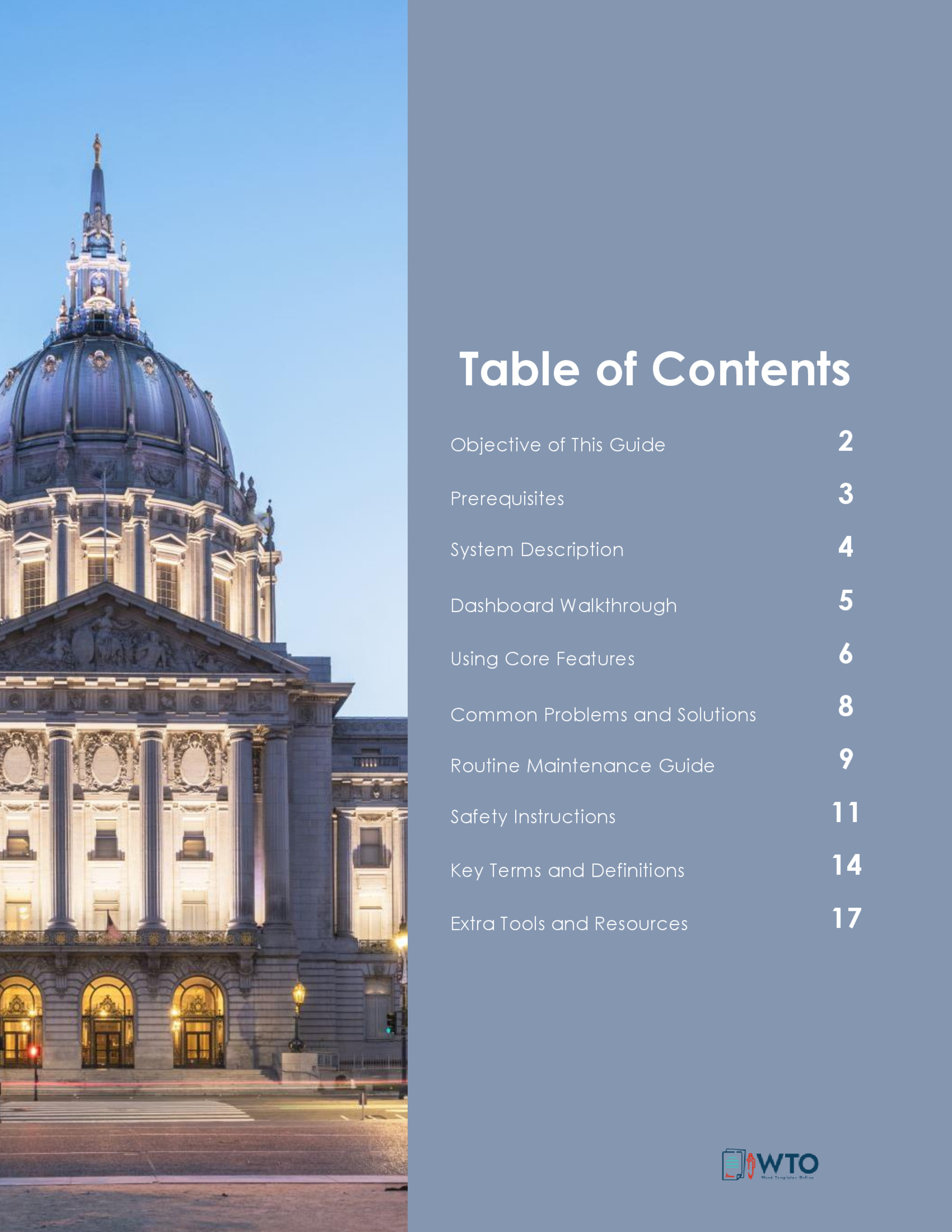
Simple templates
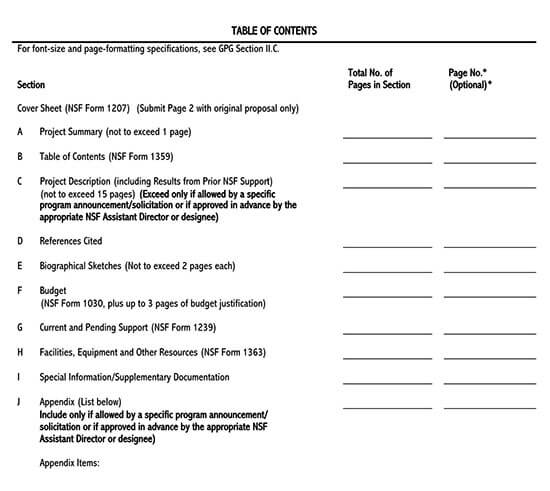
What is a Table of Contents?
A Table of Contents (TOC) is an organized list of all the parts of a document or book organized in the order in which the parts appear.
The TOC usually contains the titles, chapters, figures, and major sections of a document clearly labeled by their page number. It should be added last or updated after completing the whole document or book to capture all the contents accurately.
The Purpose of table of contents
If a book, business proposal , business report , or publication is long enough to include chapters, then a TOC will likely be included at the beginning of the book, report, or publication.
The TOC provides a sequential list of the book’s organizational structure, most commonly denoting the title, chapter number, and the starting page location. The chapter, page number, and title will help guide the reader in finding specific sections.
Basically, it serves two main purposes; one is to provide the reader with a general overview of what is contained in the document and how the content is organized, and the other is to enable the reader to go directly to the specific section of an on-line document.
Key Elements of a Table of Contents
The TOC is where one lists the chapters and major sections of their document, together with their page numbers. A clear and well-out table is very important as it indicates a quality paper is structured.
The key elements that should be included in the TOC are:
- The page titles
- Clear headings and subheadings
- The page numbers that show where in the document each section can be found
When creating your table, make sure to include all level one and two headings. You may also decide to include level three headings, although they are optional to include and should not be included in the TOC has reached its maximum length of two pages.
Level One: CHAPTER 2: Literature Review
Level Two: 2.1 Overview of Information
Level Three: 2.1.1 Discipline of Knowledge
Ensure that you use clear headings throughout your document to make your table easy to understand. Keep in mind that the reader will see the table first before reading through your document.
Other things to include in your table include the appendices and tables. Including these two, however, depend largely on how many there are in your document.
If there are more than three tables and figures, you might consider listing them on a separate page. Else, you can include them in your table.
Steps to Create a Table of Contents in MS Word
For you to create a TOC in Microsoft Word, you must first define what you’d like to include in this part. First, start off by applying the different heading styles throughout your document.
Once you’ve done that, follow these steps to insert a TOC in MS Word automatically:
Add a title on the TOC page. Ensure that you follow the standard format specific to your document or as per your department’s guidelines.

Put your cursor where you want the table to go. The table is usually included between the abstract and the introduction.
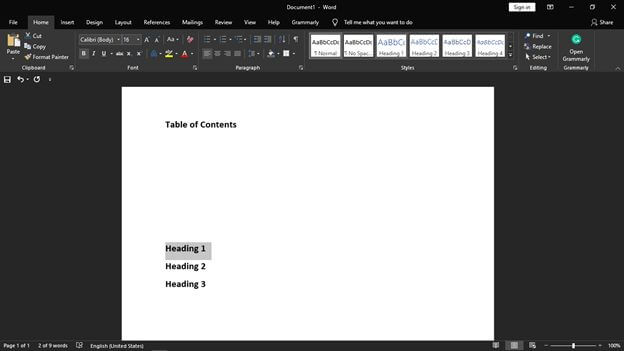
In the ribbon, find the reference section and locate the TOC section. Use the search tab on the ribbon to search for the table.
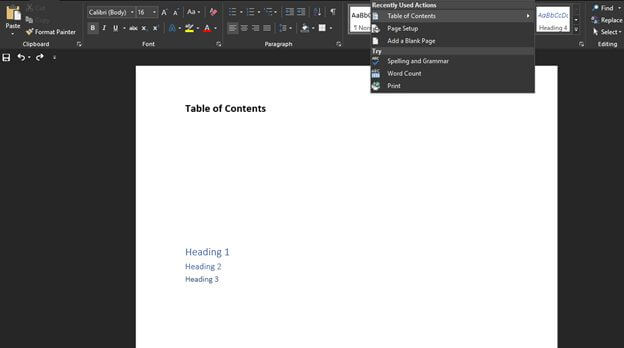
Click the arrow that is next to the TOC icon and select Custom Table of Contents. Here, select the level of heading that you would like to include in your table and also make the necessary adjustments to each level by clicking the modify button.
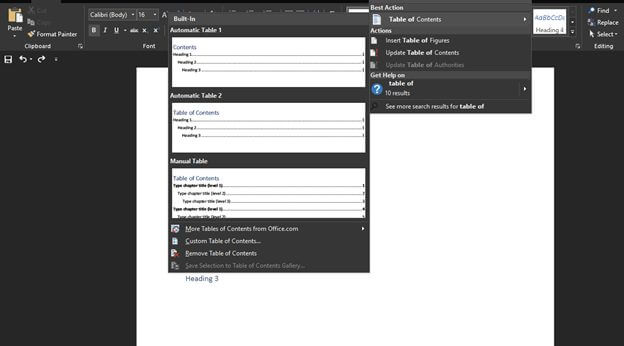
Click on Custom table of contents.
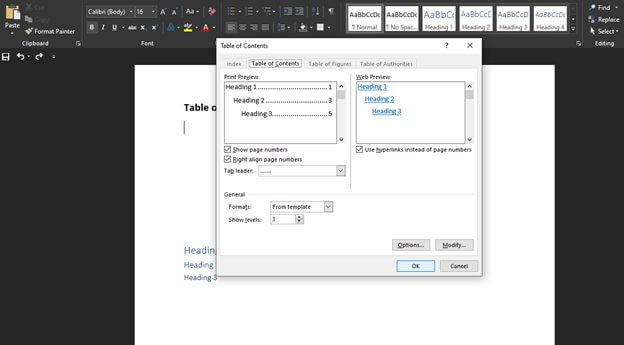
After you’ve made sure that everything is OK. Click OK, and your TOC will be automatically generated.
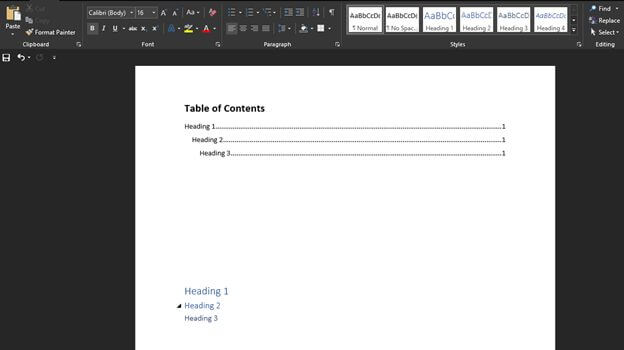
Tips on Preparing Table of Contents
It is recommended that you use your TOC template last after to make sure that it provides a clear overview of your document. You can still draw up a mock TOC in your early stages of writing to help you formulate a structure and think through your topics and how you are going to research.
Make sure that all the heading levels are properly defined in your document before inserting the template.
Remember that the reader will most likely go through your table first before diving into the document to get an overview of what to expect. Make sure that your TOC is clear and that it captures your entire document.
Frequently Asked Questions
No, the TOC is basically a snapshot of the headings, tables, and page numbers in a document and does not automatically update itself as you make changes. Anytime you make changes to your document, you can update it by simply right-clicking on it and selecting the update field.
No, the TOC is usually included between the abstract and the introduction.
Yes, the maximum length of a TOC should be two pages, regardless of the type of document you are writing.
Regardless of your document’s type or size, using a TOC can help direct the readers to exactly where they want to be. Other than making your document more reader-friendly, the table also makes it easier for the author to go back and change or update contents throughout their document if necessary. By default, MS Word generates a TOC when you use the first three built-in heading styles, i.e., Heading 1, Heading 2, and Heading 3. To apply the different heading styles, simply select the style from the “Home” tab, or you can use a TOC template. Once you’ve properly defined the heading styles, follow the procedure given above to insert your table automatically.
About This Article

Was this helpful?
Great! Tell us more about your experience
Not up to par help us fix it, keep reading.

8 Free Move-Out Cleaning Checklists – Editable

10 Free Homeschool Report Card Templates

Free Hoarder Cleaning Checklist Templates

Caregiver Schedule / Daily Checklist Templates
Thank you for your feedback.
Your Voice, Our Progress. Your feedback matters a lot to us.
Have a language expert improve your writing
Run a free plagiarism check in 10 minutes, generate accurate citations for free.
- Knowledge Base
- Research paper
How to Create a Structured Research Paper Outline | Example
Published on August 7, 2022 by Courtney Gahan . Revised on August 15, 2023.

A research paper outline is a useful tool to aid in the writing process , providing a structure to follow with all information to be included in the paper clearly organized.
A quality outline can make writing your research paper more efficient by helping to:
- Organize your thoughts
- Understand the flow of information and how ideas are related
- Ensure nothing is forgotten
A research paper outline can also give your teacher an early idea of the final product.
Instantly correct all language mistakes in your text
Upload your document to correct all your mistakes in minutes

Table of contents
Research paper outline example, how to write a research paper outline, formatting your research paper outline, language in research paper outlines.
- Definition of measles
- Rise in cases in recent years in places the disease was previously eliminated or had very low rates of infection
- Figures: Number of cases per year on average, number in recent years. Relate to immunization
- Symptoms and timeframes of disease
- Risk of fatality, including statistics
- How measles is spread
- Immunization procedures in different regions
- Different regions, focusing on the arguments from those against immunization
- Immunization figures in affected regions
- High number of cases in non-immunizing regions
- Illnesses that can result from measles virus
- Fatal cases of other illnesses after patient contracted measles
- Summary of arguments of different groups
- Summary of figures and relationship with recent immunization debate
- Which side of the argument appears to be correct?
Prevent plagiarism. Run a free check.
Follow these steps to start your research paper outline:
- Decide on the subject of the paper
- Write down all the ideas you want to include or discuss
- Organize related ideas into sub-groups
- Arrange your ideas into a hierarchy: What should the reader learn first? What is most important? Which idea will help end your paper most effectively?
- Create headings and subheadings that are effective
- Format the outline in either alphanumeric, full-sentence or decimal format
There are three different kinds of research paper outline: alphanumeric, full-sentence and decimal outlines. The differences relate to formatting and style of writing.
- Alphanumeric
- Full-sentence
An alphanumeric outline is most commonly used. It uses Roman numerals, capitalized letters, arabic numerals, lowercase letters to organize the flow of information. Text is written with short notes rather than full sentences.
- Sub-point of sub-point 1
Essentially the same as the alphanumeric outline, but with the text written in full sentences rather than short points.
- Additional sub-point to conclude discussion of point of evidence introduced in point A
A decimal outline is similar in format to the alphanumeric outline, but with a different numbering system: 1, 1.1, 1.2, etc. Text is written as short notes rather than full sentences.
- 1.1.1 Sub-point of first point
- 1.1.2 Sub-point of first point
- 1.2 Second point
To write an effective research paper outline, it is important to pay attention to language. This is especially important if it is one you will show to your teacher or be assessed on.
There are four main considerations: parallelism, coordination, subordination and division.
Parallelism: Be consistent with grammatical form
Parallel structure or parallelism is the repetition of a particular grammatical form within a sentence, or in this case, between points and sub-points. This simply means that if the first point is a verb , the sub-point should also be a verb.
Example of parallelism:
- Include different regions, focusing on the different arguments from those against immunization
Coordination: Be aware of each point’s weight
Your chosen subheadings should hold the same significance as each other, as should all first sub-points, secondary sub-points, and so on.
Example of coordination:
- Include immunization figures in affected regions
- Illnesses that can result from the measles virus
Subordination: Work from general to specific
Subordination refers to the separation of general points from specific. Your main headings should be quite general, and each level of sub-point should become more specific.
Example of subordination:
Division: break information into sub-points.
Your headings should be divided into two or more subsections. There is no limit to how many subsections you can include under each heading, but keep in mind that the information will be structured into a paragraph during the writing stage, so you should not go overboard with the number of sub-points.
Ready to start writing or looking for guidance on a different step in the process? Read our step-by-step guide on how to write a research paper .
Cite this Scribbr article
If you want to cite this source, you can copy and paste the citation or click the “Cite this Scribbr article” button to automatically add the citation to our free Citation Generator.
Gahan, C. (2023, August 15). How to Create a Structured Research Paper Outline | Example. Scribbr. Retrieved June 11, 2024, from https://www.scribbr.com/research-paper/outline/
Is this article helpful?
Courtney Gahan
Other students also liked, research paper format | apa, mla, & chicago templates, writing a research paper introduction | step-by-step guide, writing a research paper conclusion | step-by-step guide, what is your plagiarism score.
- Link to facebook
- Link to linkedin
- Link to twitter
- Link to youtube
- Writing Tips
How to Structure a Business Report
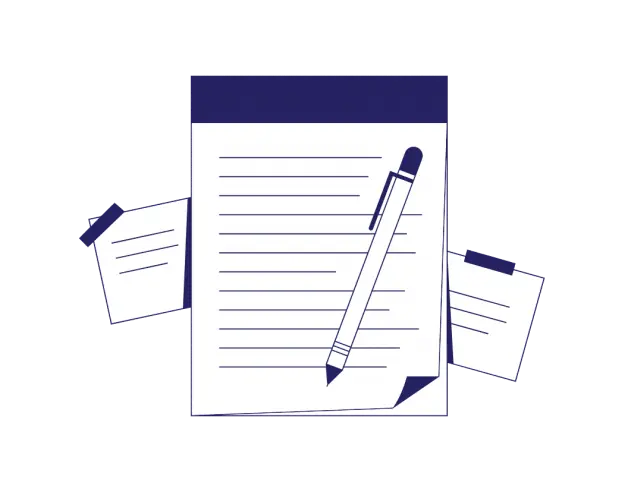
- 5-minute read
- 14th March 2019
The content of a business report will depend on what you are writing about. Even the writing style may depend on who you are writing for (although clear, concise and formal is usually best). However, there is a general structure that most business reports follow. In this post, then, we’ll look at how to structure a business report for maximum clarity and professionalism.
1. Title Page
Every business report should feature a title page . The title itself should clearly set out what the report is about. Typically, you should also include your name and the date of the report.
Most business reports begin with a summary of its key points. Try to include:
- A brief description of what the report is about
- How the report was completed (e.g., data collection methods)
- The main findings from the research
- Key conclusions and recommendations
A paragraph or two should suffice for this in shorter business reports. However, for longer or more complex reports, you may want to include a full executive summary .
3. Table of Contents
Short business reports may not need a table of contents, especially if they include a summary. But longer reports should set out the title of each section and the structure of the report. Make sure the headings here match those used in the main text. You may also want to number the sections.
4. Introduction
The introduction is the first part of the report proper. Use it to set out the brief you received when you were asked to compile the report. This will frame the rest of the report by providing:
- Background information (e.g., business history or market information)
- The purpose of the report (i.e., what you set out to achieve)
- Its scope (i.e., what the report will cover and what it will ignore)
These are known as the “terms of reference” for the business report.
5. Methods and Findings
If you are conducting original research, include a section about your methods. This may be as simple as setting out the sources you are using and why you chose them. But it could also include how you have collected and analyzed the data used to draw your conclusions.
After this, you will need to explain your findings. This section will present the results of your research clearly and concisely, making sure to cover all the main points set out in the brief.
Find this useful?
Subscribe to our newsletter and get writing tips from our editors straight to your inbox.
One tip here is to break the findings down into subsections, using headings to guide the reader through your data. Using charts and illustrations , meanwhile, can help get information across visually, but make sure to label them clearly so the reader knows how they relate to the text.
6. Conclusions and Recommendations
The last main section of your report will cover conclusions and recommendations. The conclusion section should summarize what you have learned from the report. If you have been asked to do so, you should also recommend potential courses of action based on your conclusions.
If you are not sure what to suggest here, think back to the objectives set out in your brief.
7. References
If you have used any third-party sources while writing your report, list them in a bibliography after the main report. This could include other business documents, academic articles, or even news reports. The key is to show what you have based your findings and conclusions upon.
8. Appendices (If Applicable)
Finally, you may have gathered extra documentation during your research, such as interview transcripts, marketing material, or financial data. Including this in the main report would make it too long and unfocused, but you can add it to an appendix (or multiple appendices) at the end of the document. It will then be available should your reader need it.
Summary: How to Structure a Business Report
If you are writing a business report, aim to structure it as follows:
- Title Page – Include a clear, informative title, your name, and the date.
- Summary – A brief summary of what the report is about, the data collection methods used, the findings of the report, and any recommendations you want to make.
- Table of Contents – For longer reports, include a table of contents.
- Introduction –Set out the brief you were given for the report.
- Methods and Findings – A description of any methods of data collection and analysis used while composing the report, as well as your findings.
- Conclusions and Recommendations – Any conclusions reached while writing the report, plus recommendations for what to do next (if required).
- References – Sources used in your report listed in a bibliography.
- Appendices – If you have supporting material (e.g., interview transcripts, raw data), add it to an appendix at the end of the document.
Don’t forget, too, that a business report should be clear, concise, and formal. And if you would like help making sure that your business writing is easy to read and error free, just let us know .
Share this article:
Post A New Comment
Got content that needs a quick turnaround? Let us polish your work. Explore our editorial business services.
9-minute read
How to Use Infographics to Boost Your Presentation
Is your content getting noticed? Capturing and maintaining an audience’s attention is a challenge when...
8-minute read
Why Interactive PDFs Are Better for Engagement
Are you looking to enhance engagement and captivate your audience through your professional documents? Interactive...
7-minute read
Seven Key Strategies for Voice Search Optimization
Voice search optimization is rapidly shaping the digital landscape, requiring content professionals to adapt their...
4-minute read
Five Creative Ways to Showcase Your Digital Portfolio
Are you a creative freelancer looking to make a lasting impression on potential clients or...
How to Ace Slack Messaging for Contractors and Freelancers
Effective professional communication is an important skill for contractors and freelancers navigating remote work environments....
3-minute read
How to Insert a Text Box in a Google Doc
Google Docs is a powerful collaborative tool, and mastering its features can significantly enhance your...

Make sure your writing is the best it can be with our expert English proofreading and editing.
Numbers, Facts and Trends Shaping Your World
Read our research on:
Full Topic List
Regions & Countries
- Publications
- Our Methods
- Short Reads
- Tools & Resources
Read Our Research On:
Globally, Biden Receives Higher Ratings Than Trump
- 6. Is U.S. democracy a good example to follow?
Table of Contents
- Views of the U.S.
- Confidence in Biden, Trump and other world leaders
- Differences by ideology, age and gender
- 1. Views of the U.S.
- 2. Confidence in Joe Biden
- 3. Confidence in Donald Trump
- 4. Comparing confidence in Macron, Putin and Xi to ratings of Biden and Trump
- Biden’s handling of global economic problems
- Biden’s handling of climate change
- Biden’s handling of China
- Biden’s handling of the Russia-Ukraine war
- Biden’s handling of the Israel-Hamas war
- Appendix A: Favorability of the United States since 2000
- Appendix B: Confidence in the U.S. president since 2001
- Acknowledgments
- About Pew Research Center’s Spring 2024 Global Attitudes Survey
The publics surveyed are largely skeptical that democracy in the U.S., at least in its current form, is a good example for other countries to follow. A median of four-in-ten across the 34 nations polled believe democracy in the U.S. used to be a good example for other countries to follow but has not been in recent years.
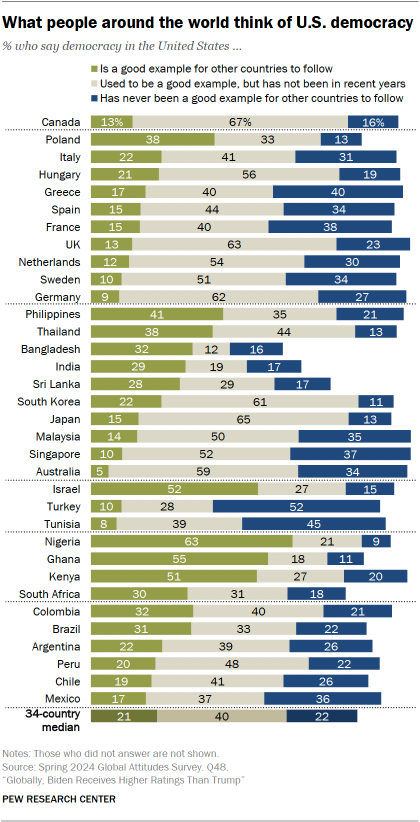
Roughly one-in-five say American democracy has never been a good example. A similar share say it is currently a good model for other countries.
Around the world, adults in advanced economies are more skeptical of U.S. democracy when compared with those in middle-income countries. In 16 of 17 high-income countries surveyed, the share of people who think American democracy used to be a good example is 40% or higher. By contrast, the share holding this opinion is under 40% in 13 of 17 middle-income countries surveyed.
The current state of American democracy receives some of its highest ratings in the sub-Saharan African nations included in the study. Half or more in Ghana, Kenya and Nigeria think U.S. democracy sets a good example for other countries. A similar share of Israelis hold this opinion.
On the other hand, in 18 of 34 countries surveyed, about a quarter or more of adults think that U.S. democracy has never been a good example to follow. Turkey stands out as the most critical of American democracy, with about half of adults (52%) holding this view.

Substantial shares of the public in several European democracies are also critical: At least three-in-ten say the U.S. has never been a good example in France, Greece, Italy, the Netherlands, Spain and Sweden.
Since spring 2021, the share who see American democracy as a good example has fallen in eight of the 13 countries where trends are available, mostly in Europe.
For instance, 32% of Italians said in 2021 that the U.S. was a good example of democracy, while 22% hold this view today. Smaller but significant decreases can be seen in Australia, Germany, Greece, the Netherlands, Spain, Sweden and the UK.
Sign up for our weekly newsletter
Fresh data delivery Saturday mornings
Sign up for The Briefing
Weekly updates on the world of news & information
- China Global Image
- Donald Trump
- Environment & Climate
- International Political Values
- Presidential Approval
- U.S. Global Image
- Vladimir Putin
- War & International Conflict
- World Leaders
How Americans and Israelis view one another and the U.S. role in the Israel-Hamas war
In east asia, many people see china’s power and influence as a major threat, how views of the u.s., china and their leaders have changed over time, comparing views of the u.s. and china in 24 countries, poles and hungarians differ over views of russia and the u.s., most popular, report materials.
1615 L St. NW, Suite 800 Washington, DC 20036 USA (+1) 202-419-4300 | Main (+1) 202-857-8562 | Fax (+1) 202-419-4372 | Media Inquiries
Research Topics
- Email Newsletters
ABOUT PEW RESEARCH CENTER Pew Research Center is a nonpartisan fact tank that informs the public about the issues, attitudes and trends shaping the world. It conducts public opinion polling, demographic research, media content analysis and other empirical social science research. Pew Research Center does not take policy positions. It is a subsidiary of The Pew Charitable Trusts .
© 2024 Pew Research Center

IMAGES
VIDEO
COMMENTS
The table of contents is usually located at the beginning of the document or book, after the title page and any front matter, such as a preface or introduction. Table of Contents in Research. In Research, A Table of Contents (TOC) is a structured list of the main sections or chapters of a research paper, Thesis and Dissertation. It provides ...
Generating the table of contents. Now you can generate your table of contents. First write the title "Contents" (in the style of a level 1 heading). Then place your cursor two lines below this and go to the References tab. Click on Table of Contents and select Custom Table of Contents…. In the popup window, select how many levels of ...
To summarize, the following steps will help you create a clear and concise table of contents to guide readers through your research paper: 1. Insert the table of contents after the title page. 2. List all the sections and subsections in chronological order. 3. Paginate each section. 4. Format the table of contents according to your style guide. 5.
The table of contents is where you list the chapters and major sections of your thesis, dissertation, or research paper, alongside their page numbers. A clear and well-formatted table of contents is essential, as it demonstrates to your reader that a quality paper will follow. ... or research paper. In addition to a table of contents, you might ...
Indent the first line of every paragraph of text 0.5 in. using the tab key or the paragraph-formatting function of your word-processing program. Page numbers: Put a page number in the top right corner of every page, including the title page or cover page, which is page 1. Student papers do not require a running head on any page.
A multi-level table of contents also further divides sections into 'level 3' headings. This option can get messy quickly, so proceed with caution. Remember your table of contents should not be longer than 2 pages. A multi-level table is often a good choice for a shorter document like a research paper.
The table of contents shows readers what topics are covered in the report, how those topics are discussed (the subtopics), and on which page numbers those sections and subsections start. In creating a table of contents, you have a number of design decisions: Levels of headings to include: In longer reports, consider including only the top two ...
A table of contents (TOC) is a list of a research paper's main sections and subsections, along with their page numbers. It serves as a roadmap for the reader, allowing them to find the information they need within the paper quickly. The table of contents for a research paper is usually placed at the beginning of the paper, after the title ...
For a standard psychology paper, it might include listings for the introduction, method, results, and discussion sections of your paper. While the APA may not specify guidelines for a table of contents, you should use the basic APA format for formatting your table of contents: Use one-inch margins on all sides. Use 12-point Times New Roman font.
A table of contents is a list, usually on a page at the beginning of a piece of academic writing, which outlines the chapters or sections names with their corresponding page numbers. In addition to chapter names, it includes bullet points of the sub-chapter headings or subsection headings. It usually comes right after the title page of a ...
To automatically insert a table of contents in Microsoft Word, follow these steps: Apply heading styles throughout the document. In the references section in the ribbon, locate the Table of Contents group. Click the arrow next to the Table of Contents icon and select Custom Table of Contents.
A working table of contents should begin with a title. This title may change as you draft your text, but a working title will help you focus your thoughts as you devise the headings and plan the content for the main parts, chapters, sections and subsections that should be added beneath it. All headings, whether numbered or not, should be ...
Indicate second-level headings under the corresponding first-level heading. If applicable, indicate third-level headings under the corresponding second-level heading. Write the page number for each heading. Put the content in a two-column table. Title the page with "Table of Contents.".
A short essay or research paper written in MLA format requires no table of contents. However, if your written report, research paper, or other longer work is more than five pages, it is helpful to ...
Make a table with two columns. Then, place the headings and subheadings in the first column in order. Put the applicable page numbers in the second column. Check that the subheadings are located underneath the correct headings, indented to the right. Make sure there are page numbers for the subheadings listed as well.
October 6, 2023. Summary: Tables of contents provide a page overview and direct access to specific sections. When designing a table of contents, carefully compare different placement and styling options to maximize usability. The table of contents has been a standard feature in book publication for centuries, helping readers locate specific ...
1. Research Paper Title. A research paper title is read first, and read the most. The title serves two purposes: informing readers and attracting attention. Therefore, your research paper title should be clear, descriptive, and concise. If you can, avoid technical jargon and abbreviations.
Step 4: Click the arrow that is next to the TOC icon and select Custom Table of Contents. Here, select the level of heading that you would like to include in your table and also make the necessary adjustments to each level by clicking the modify button. Click on Custom table of contents.
A decimal outline is similar in format to the alphanumeric outline, but with a different numbering system: 1, 1.1, 1.2, etc. Text is written as short notes rather than full sentences. Example: 1 Body paragraph one. 1.1 First point. 1.1.1 Sub-point of first point. 1.1.2 Sub-point of first point.
The main findings from the research; Key conclusions and recommendations; A paragraph or two should suffice for this in shorter business reports. However, for longer or more complex reports, you may want to include a full executive summary. 3. Table of Contents. Short business reports may not need a table of contents, especially if they include ...
Since spring 2021, the share who see American democracy as a good example has fallen in eight of the 13 countries where trends are available, mostly in Europe. For instance, 32% of Italians said in 2021 that the U.S. was a good example of democracy, while 22% hold this view today. Smaller but significant decreases can be seen in Australia ...